A New Chapter in Climate Leadership: Jodi Trendler Steps Into a Pivotal Role
Norwalk is making meaningful moves toward a more sustainable future, starting with new leadership.
Jodi Trendler has just been appointed as the city’s first-ever Director of Sustainability and Resilience, a milestone that signals Norwalk’s growing commitment to tackling climate-related challenges head-on.
From stronger flood planning to smarter environmental policy, her role—and the citywide initiatives ahead—will shape a safer, more resilient future for Norwalk residents.
Who is Jodi Trendler?
Jodi Trendler brings over two decades of experience in sustainability planning, community engagement, and environmental leadership. She has worked with local governments, nonprofits, and regional coalitions to implement practical strategies that create real impact.
In her new role with the City of Norwalk, which sits within the Mayor’s Office, Trendler will collaborate with city departments, the Common Council, and local stakeholders to guide policy development and best practices around sustainability, climate resilience, and equitable planning.
You can read the official announcement here.
 “As the new Director of Sustainability and Resilience, I’m truly impressed by the incredible work in this area that has already been accomplished. From the development of Norwalk’s comprehensive Sustainability and Resilience Plan (SRP), to the implementation of complete streets and the alignment of new zoning with sustainability best practices, it’s clear that Norwalk is leading by example. This progress reflects the dedication and expertise of Mayor Rilling and the City’s leadership and staff, and I’m honored to join such a knowledgeable and committed team. I am very excited about helping tell the full story of Norwalk’s achievements and to advancing new initiatives—like the Flood Resilience Plan—that will make our community even more sustainable, resilient, and future ready.”
“As the new Director of Sustainability and Resilience, I’m truly impressed by the incredible work in this area that has already been accomplished. From the development of Norwalk’s comprehensive Sustainability and Resilience Plan (SRP), to the implementation of complete streets and the alignment of new zoning with sustainability best practices, it’s clear that Norwalk is leading by example. This progress reflects the dedication and expertise of Mayor Rilling and the City’s leadership and staff, and I’m honored to join such a knowledgeable and committed team. I am very excited about helping tell the full story of Norwalk’s achievements and to advancing new initiatives—like the Flood Resilience Plan—that will make our community even more sustainable, resilient, and future ready.”
Why Flood Resilience Matters Now
Like many coastal communities, Norwalk faces increasing threats from storm surge, sea level rise, and inland flooding due to heavier, more frequent rain events. These risks don’t affect all residents equally. Some neighborhoods are more vulnerable due to geography, infrastructure, or resource access.
That’s why the City is investing in a long-term resilience strategy focused not just on response, but prevention, equity, and sustainability.
What Is the Citywide Community Flood Resilience Plan?
One of Trendler’s first major initiatives is supporting The Department of Planning and Zoning's development of a Citywide Community Flood Resilience Plan, a strategic blueprint to help Norwalk prepare for climate-related flooding in coastal and inland areas.
The plan, funded by a grant from the National Coastal Resilience Fund (NCRF), focuses on long-term, nature-based solutions to reduce the risk and impact of flooding events. While the City already has a robust stormwater management program, the new plan emphasizes community resilience, especially in neighborhoods that are most vulnerable to climate change.
The project includes extensive public engagement, including workshops, surveys, and digital feedback platforms, with a commitment to reaching residents of all backgrounds, particularly renters, seniors, low-income families, and others who may face barriers to adaptation. The City is currently reviewing proposals for the Citywide Community Flood Resilience Plan, which will guide long-term adaptation strategies.
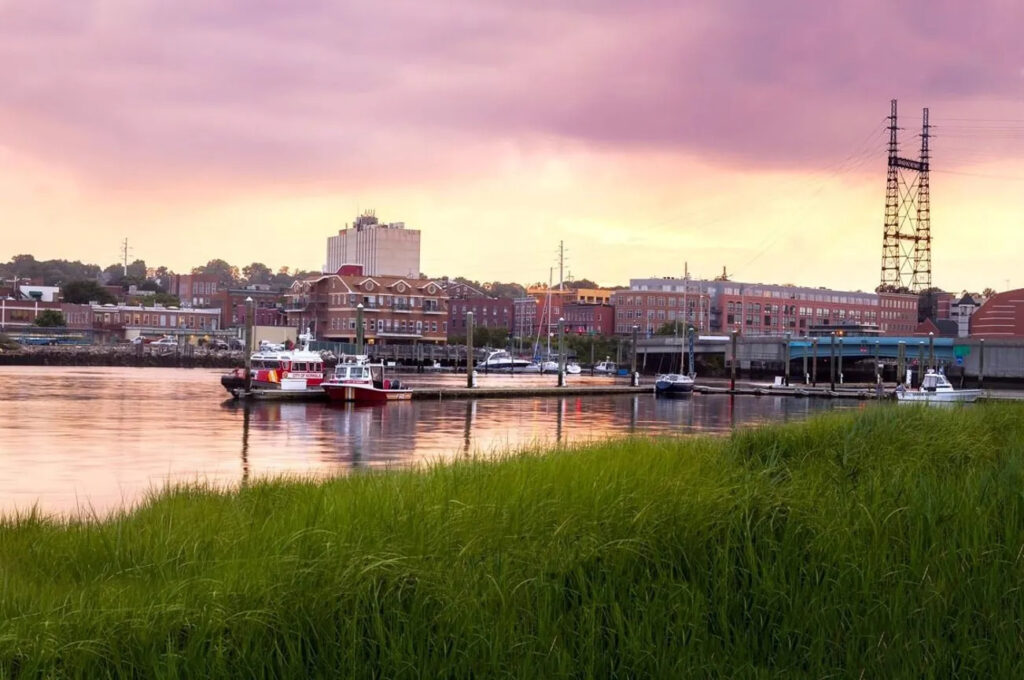
What Comes Next
As the City selects a consultant for the Flood Resilience Plan, Jodi Trendler will help ensure that public engagement remains a central focus. Community workshops and outreach will begin in the coming months, with opportunities for residents to share their insights, concerns, and ideas.
Through Norwalk Tomorrow and other city channels, residents can stay informed and help play a crucial role in shaping the city’s path forward.
Working Together for Norwalk’s Future
The Flood Resilience Plan reflects a growing partnership between City leadership, including the Mayor’s Office, Planning & Zoning, and Norwalk Tomorrow. Jodi Trendler’s role will be essential in ensuring the selected consultant's approach aligns with the City’s goals, values, and environmental vision.
As the project progresses, Norwalk Tomorrow will help keep the community informed—and involved—every step of the way.
How You Can Stay Involved
Norwalk Tomorrow will continue to keep the public informed as the planning process unfolds. From public workshops to plan updates, residents will have opportunities to participate and share their input every step of the way.
To stay up to date on the Citywide Community Flood Resilience Plan and other initiatives, visit Norwalk Tomorrow's website. And don’t forget to welcome Jodi here! Celebrating Earth Day in Norwalk: A Community-Wide Commitment to Sustainability and Action
Despite a rainy forecast, the spirit of community and environmental stewardship was in full force at Norwalk’s Earth Day Festival on Saturday, April 26! Dozens of vendors, city departments, educators, environmentalists, and nonprofit organizations came together on the Norwalk Green to celebrate sustainability, share resources, and connect with residents.
The mission of the Norwalk Earth Day Festival is to host a fun, community-led, and family-oriented event that inspires action toward a sustainable future by providing educational experiences, engaging activities, and showcasing eco-friendly solutions. The goal is to foster a collective commitment to protecting our planet and improving our personal well-being, while also highlighting the work the City of Norwalk is doing to create a greener and healthier city for its residents.
The festival featured
more than 60 exhibitors and vendors offering everything from composting tips to locally grown produce, reflecting Norwalk’s philosophy that meaningful change happens through local partnerships and thoughtful community action.
In the week leading up to Earth Day, nearly 100 young rowers from Norwalk’s local rowing clubs (
Connecticut Boat Club,
Maritime Rowing Club, and
Norwalk River Rowing Association) organized cleanups along the Norwalk River. Through their enthusiasm in collecting over 1,000 pounds of trash, these budding environmentalists truly shared that they ‘
love where they row’. Their efforts reflect the growing momentum among youth to take active roles in preserving natural spaces for recreation and community well-being.
[caption id="attachment_2500" align="aligncenter" width="1024"]

Photo credit: Tracy Craighead[/caption]
A Brief Look Back: The History of Earth Day
First celebrated in 1970,
Earth Day has grown into a global call for environmental awareness and action and is considered to be the dawn of the modern environmental movement. The event was born out of a desire to elevate ecological consciousness and is now observed by over 1 billion people worldwide, making it the largest secular day of protest in the world.
In Norwalk, CT, Earth Day isn’t just about celebrating the planet—it’s about honoring the
ongoing efforts that protect it, year after year.
Initially, the idea of this Norwalk event was born out of the COVID pandemic, when members of the
Norwalk Green Association began discussing ways to build a stronger sense of community. They decided to organize an Earth Day celebration that would spotlight the efforts of local environmental organizations and support the
City’s Keep Norwalk Beautiful cleanup initiative. By 2022, what started as a small, neighborhood-focused event on the Norwalk Green had grown significantly in size and impact, attracting participants from across Norwalk and nearby towns.
As Tracy Craighead, Chair of event says, “For us, this day is all about conveying the hopeful message about the potential for change and the importance of working together as a community because it’s going to take all of us: activists, citizens, businesses, community leaders, artists and governments to create the necessary change that will have a positive impact on preserving the planet for future generations.” And she adds, “I am thrilled about how this grass roots community-led effort has grown through its collaboration with the City, and now our message is getting out to the public in an educational, engaging, and fun way that keeps folks coming back each year.”
Festival Highlights: Collaboration, Curiosity & Connection
Attendees brought enthusiasm and genuine interest to the event. Many vendors reported a steady stream of visitors eager to learn more about everything from native plants and pollinators to clean energy and coastal resilience.
Local farms, city agencies, youth programs, and sustainability organizations all contributed to the festival’s sense of purpose and possibility.
Channel News coverage captured the day's energy, with
Union City Farm owner Patrick Blanchette noting the event’s importance in bringing together like-minded community members.
Additionally, this year’s Earth Day celebration also featured a wide variety of interactive events and experiences, including:
- Eco Trashion Show – A creative fashion made from repurposed materials
- Walks & Guided Experiences, such as:
- Community, History & Nature Walk
- Wall Street Corridor Revitalization Walk
- Forest Bathing Walk with the Norwalk Land Trust
- Spirit Walk with Al Forte
- A Talk with David Pogue: “10 Reasons for Climate Hope…10 Actions You Can Take Now!” at Mill Hill Historic Park
- Children’s Storytime at First Congregational Church
- Tree Planting Ceremony
- Live Music Performances at the gazebo on the Norwalk Green:
Together, these events created a festive and educational atmosphere that invited residents of all ages to connect with nature and each other.
[caption id="attachment_2501" align="aligncenter" width="1024"]
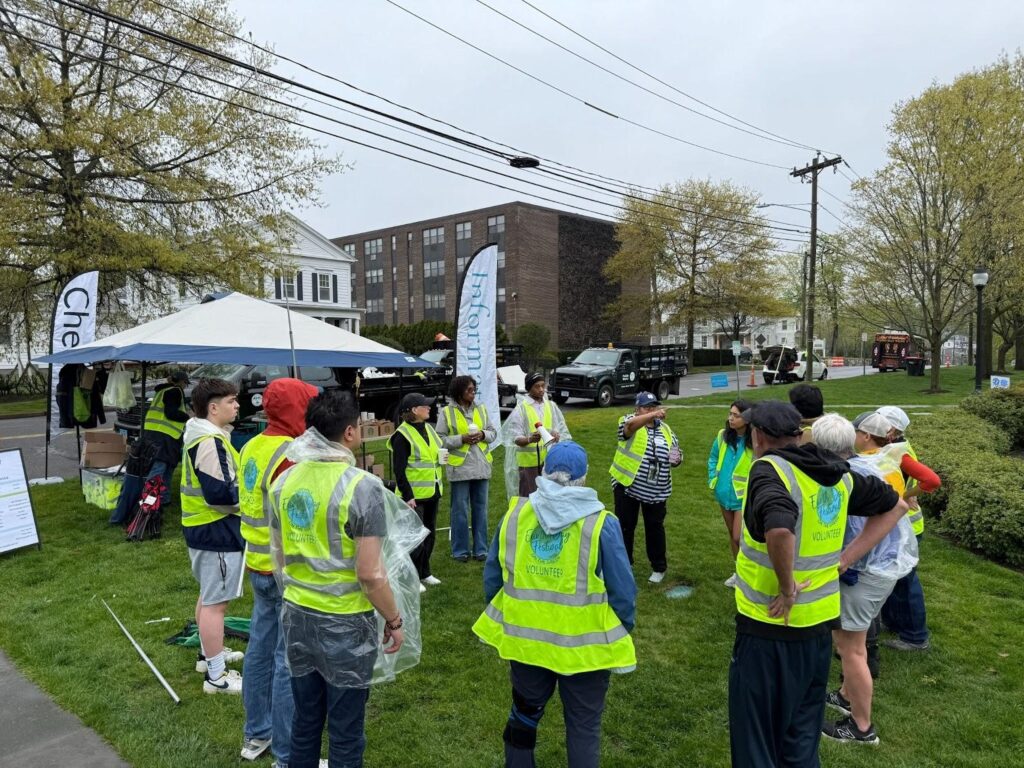
Photo credit: Tracy Craighead[/caption]
A Reflection of Norwalk’s Environmental Goals
The Earth Day Festival also reflects the City of Norwalk’s broader sustainability goals. Under the leadership of Jodi Trendler, the City’s newly appointed Director of Sustainability and Resilience, Norwalk is taking actionable steps toward climate resilience, environmental education, and community-driven planning.
“This event embodies the kind of community connection and education that moves our city closer to its sustainability goals,” said Jodi Trendler, Director of Sustainability and Resilience for the City of Norwalk. “Earth Day is more than a celebration, it’s a reminder that when we work together, we create a lasting impact!”
Events like this serve as both celebration and catalyst, unifying the people and partnerships that will shape a greener, healthier Norwalk for generations to come. They are also a meaningful entry point for younger activists, many of whom are stepping up to participate in city cleanups, lend a hand at exhibitor tables, bring creativity to repurposed lawn sign art, and even take the spotlight in the eco-fashion show at the Earth Day event. Their energy and enthusiasm reflect the event’s growing power to inspire the next generation of environmental stewards.
[caption id="attachment_2502" align="aligncenter" width="881"]
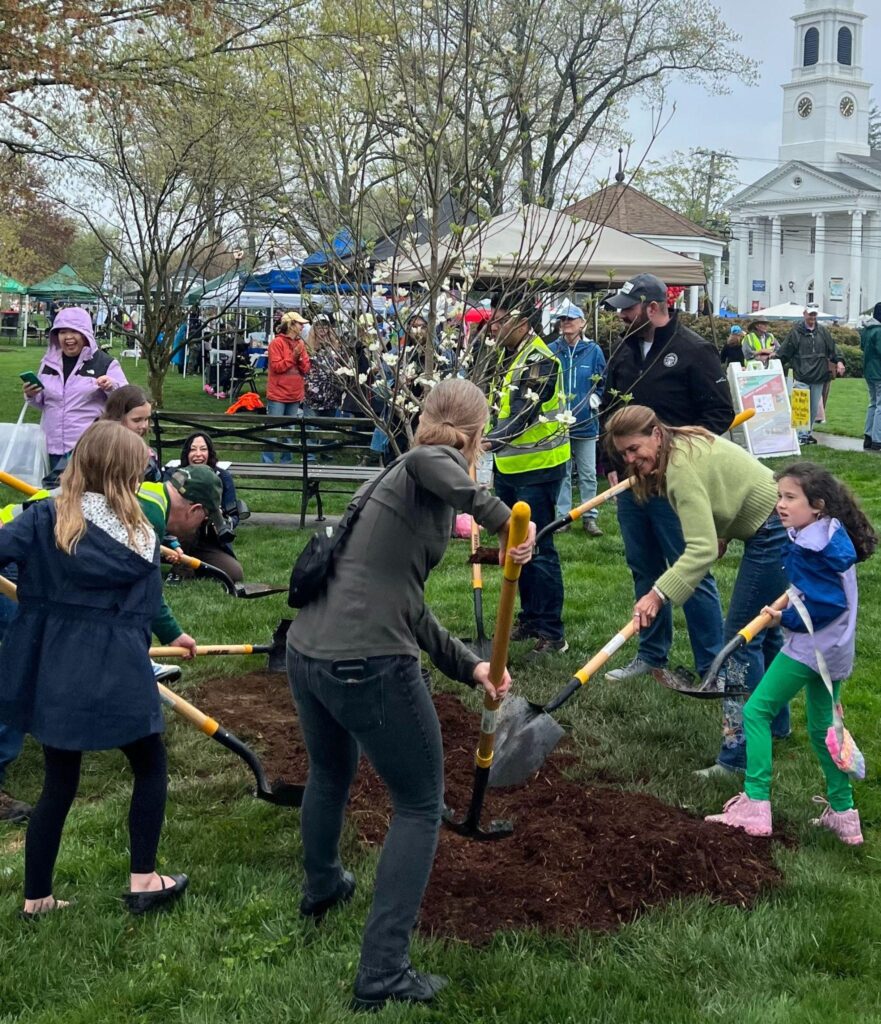
Photo credit: Tracy Craighead[/caption]
Looking Ahead
Those who attended left inspired! With a growing number of grassroots partners, local advocates, and environmentally conscious residents and businesses, Norwalk continues to make sustainability a shared priority. It is this “collective action” that is encouraging the Norwalk community to step up efforts together to combat climate change, protect biodiversity, and preserve our ecosystems.
We’re already looking forward to next year, and hope to see you there!
[caption id="attachment_2503" align="aligncenter" width="768"]
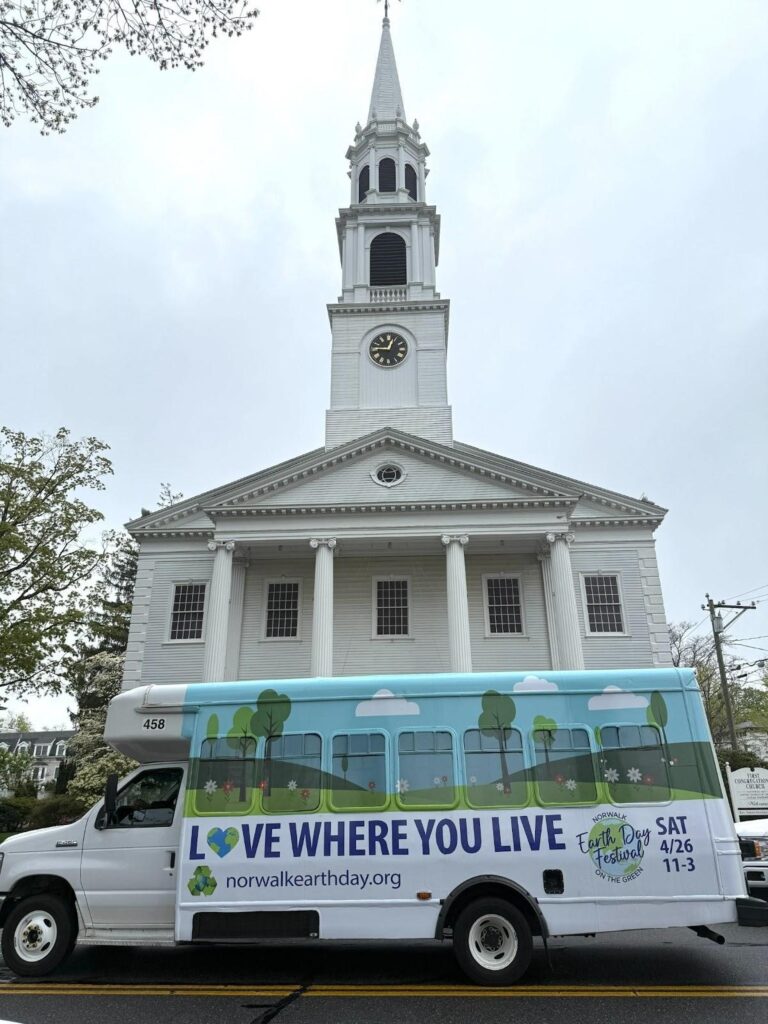
Photo credit: Tracy Craighead[/caption]
Conserving Norwalk’s Water: A Community Approach to Sustainability
Norwalk’s water system plays a vital role in the health of the city’s homes, businesses, and environment. From wastewater management at the Water Pollution Control Authority to everyday conservation reminders, Norwalk is taking active steps to steward its water resources, especially as climate conditions grow more unpredictable.
Understanding Norwalk’s Water Supply
Unlike many communities that rely solely on surface water, Norwalk's water supply is primarily sourced from surface reservoirs, with supplemental groundwater from aquifers. These aquifers require special care and long-term planning to preserve. And with drier summers and heavier rainfall events becoming more common due to climate change, the city continues exploring new ways to conserve water, improve infrastructure, and engage the public.
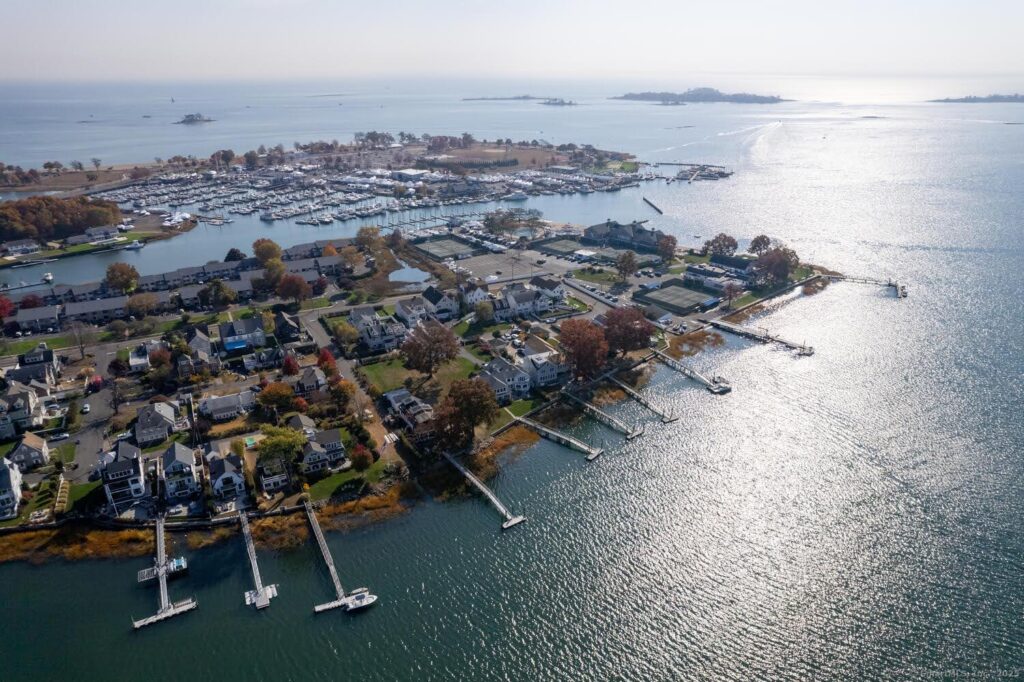
Why Water Sustainability Matters in Norwalk
Water challenges in Norwalk aren’t one-size-fits-all. While the city primarily relies on surface reservoirs, protecting groundwater sources remains critical for long-term resilience. Overdrawing aquifers can lead to lower water tables and future supply risks.
Every gallon saved helps reduce the burden on treatment facilities, stormwater systems, and natural habitats. For residents, conserving water helps:
- Lower monthly utility bills
- Reduce wear on appliances and plumbing
- Support local resilience during droughts or water advisories
- Ensure a reliable supply for future generations
- Sustainability isn't just a citywide goal—it's a way for every household to make a measurable impact.
- Ongoing Conservation Efforts
The
Norwalk Water Pollution Control Authority (WPCA) manages over 200 miles of sewer pipelines and oversees the treatment of millions of gallons of wastewater daily. It works alongside other city departments to ensure the water system is efficient and resilient.
Exciting upgrades are already underway:
- Supervisory Control and Data Acquisition (SCADA) system modernization to improve real-time water monitoring
- Pump station renovations to support stormwater and wastewater flow
- Sewer rehabilitation projects that reduce leaks and groundwater intrusion
These efforts help reduce system strain, protect the Norwalk harbor, and prepare the city for future water demands.
Conservation Starts at Home
While citywide upgrades help build the foundation for long-term sustainability, individual households play a crucial role in supporting Norwalk’s water goals. Every faucet turned off and every leaky pipe repaired adds up over time. In fact, residential water use accounts for a significant portion of daily demand, so conservation at the local level can have a real, measurable impact.
Residents can support Norwalk’s water conservation goals by making smart choices at home. Small steps like installing low-flow fixtures, using rain barrels for irrigation, and fixing leaks promptly can significantly reduce household water use.
While Norwalk’s WPCA focuses on wastewater management, residents can check with local utilities like
South Norwalk Electric and Water (SNEW) for information on any available rebates or efficiency programs that may help reduce overall resource consumption.
Most importantly, residents can also take simple, everyday steps to reduce waste and keep water resources healthy:
- Taking shorter showers
- Running the dishwasher and laundry only when you have a full load
- Fixing leaks in your home
- Installing low-flow toilets in your home or adding a water displacement device
- Shutting off the faucet while brushing teeth and soaping up in the shower
- Collecting rainwater
- Sweeping the patio and driveway instead of using a hose
- If everyone made small changes citywide, it could make a significant impact on our overall water demand.
Citywide Conservation Leadership
Norwalk’s Conservation Office plays a vital role in protecting water resources. The office administers and enforces the city’s Inland Wetland Regulations, which are designed to safeguard watercourses and wetlands from potentially hazardous land uses-especially in public drinking water supply areas. The Conservation Office also provides recommendations on natural resources and open space plans, ensuring that water quality and environmental health remain central to city planning.
Protecting the Norwalk Coastline and Long Island Sound
Norwalk is committed to protecting and improving water quality in Long Island Sound. The city’s Plan of Conservation and Development (POCD) 2019–2029 outlines strategies for managing stormwater, preserving wetlands, and enhancing natural buffers to reduce pollution and runoff into the Sound. These efforts support both environmental health and recreational opportunities for residents and visitors.
View our FAQs for more information.
"The city’s POCD specifically addresses the need to balance growth with environmental protection, emphasizing water resource management and conservation as key priorities for Norwalk’s future."
Looking Ahead: A Sustainable, Water-Smart Norwalk
As dry weather alerts and seasonal restrictions continue, Norwalk is committed to keeping residents informed and involved. The city will continue upgrading systems like the WPCA and promoting conservation campaigns across neighborhoods.
Through thoughtful planning and active community participation, Norwalk is building a sustainable future for its water. By doing our part—from reducing indoor water use to supporting large-scale infrastructure upgrades—we can ensure a stronger, more resilient Norwalk for generations to come.
Stay up to date on Norwalk’s water-related projects and plans by visiting the
Harbor Management Plan and subscribing to our Norwalk Tomorrow newsletter below.
Building a More Livable Norwalk: Advancing Affordable Housing Initiatives
Discover how Norwalk is advancing affordable housing through strategic planning, zoning reforms, and community collaboration. Learn about the City's initiatives to create a more inclusive, livable, and equitable future.
Affordable housing is a cornerstone of Norwalk’s vision for a thriving, inclusive community. As the City continues to grow, it faces the challenge of ensuring housing remains accessible across all income levels. Through strategic planning, innovative policies, and community collaboration, Norwalk, Connecticut, is addressing these challenges head-on to create a more livable and equitable city.

Understanding Norwalk’s Affordable Housing Landscape
The City of Norwalk recognizes that housing affordability is critical for economic vitality and social equity.
According to the City’s Affordable Housing Action Plan (AHAP), affordable housing is defined as units that cost no more than 30% of a household’s income. This definition underpins the City’s efforts to assess housing needs and implement solutions that benefit current and future residents.
To develop Norwalk’s AHAP, the City:
- Conducted a comprehensive inventory of existing housing stock.
- Analyzed affordability gaps and population trends.
- Projected medium and long-term housing needs.
- Developed strategies to safeguard affordability while promoting economic opportunities
- Implemented objective design standards to streamline approvals for housing projects.
- Expanded partnerships with nonprofit developers.
- Explored public land for housing and continuing to apply for state funding.
The planning process included several public participation opportunities, including interviews with local housing stakeholders, round table discussions with residents, housing needs webinars, and in-person events. In addition, the Affordable Housing Plan Advisory Committee held pop-up events at various city events and released a joint survey with the
Norwalk Redevelopment Agency on housing.
This process also included a
housing needs assessment, which played a crucial part in developing the recommendations and actions needed for Norwalk. This assessment was composed of extensive community input, as well as data analysis.
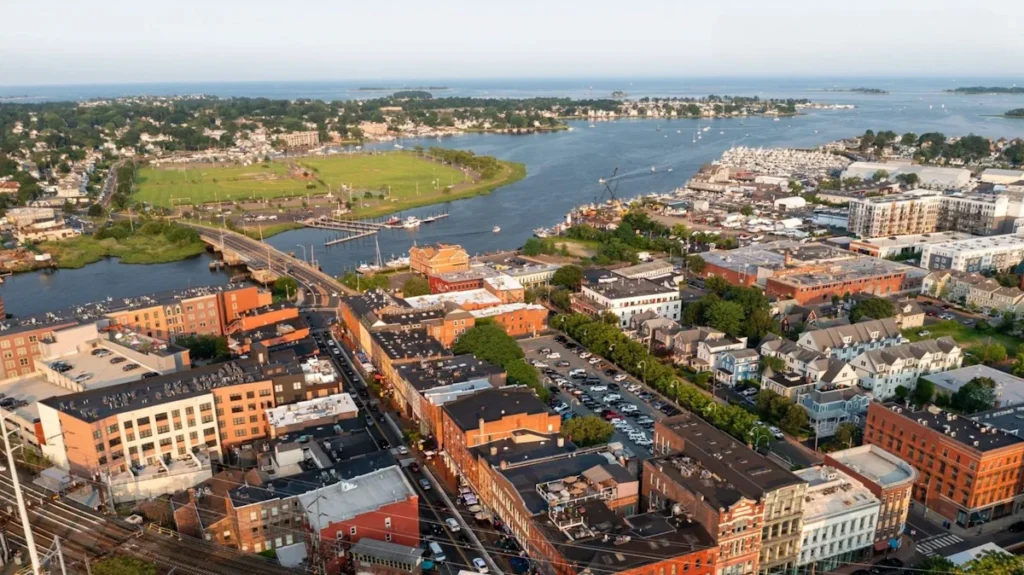
Recommendations of the AHAP were consolidated into four categories:
- Zoning and Land Use, such as revising zoning regulations
- Public Private Partnerships, such as constructing new affordable housing units through underutilized City-owned land
- Tax and Financing Innovations, such as a local tax incentive to facilitate affordable housing, like senior or condominium development.
- Federal and State Advocacy, such as lobbying to change barriers to unit types and expand affordable housing programs.
To learn more about action items, see pages 5-1 through 5-9 of the
AHAP.
What Norwalk Has Already Started to Tackle
Norwalk has already taken meaningful steps toward increasing access to affordable housing.
For example, the
Planning & Zoning Commission has approved amendments to the workforce housing regulations to allow two bedroom units to count as one and a half workforce units. This adds an incentive for developers to designate more two bedroom units, which was an identified demand in the needs assessment.
The Planning & Zoning Commission is also contemplating allowing recertified workforce households to increase their income up to 90% of the State Median Income (SMI), targeting households with incomes that may not qualify for market-rate or affordable units.
On the legislative front, the Planning & Zoning Department is working on three proposals, including:
- Lobbying for state legislation to promote construction of grocery stores that provide fresh produce and groceries to underserved communities through tax and zoning incentives. Access to food is an important resource in densely populated areas that are walkable.
- Lobbying for state legislation to allow various municipalities and the county government combined to take ownership of homes that are abandoned, blighted, or otherwise distressed and rehabilitate the structures. The buildings would be sold via a lottery system to a family earning no more than 80% of the county’s median income.
- Identifying and revising several state legislation items regarding condominiums and eliminating hurdles to homeownership.
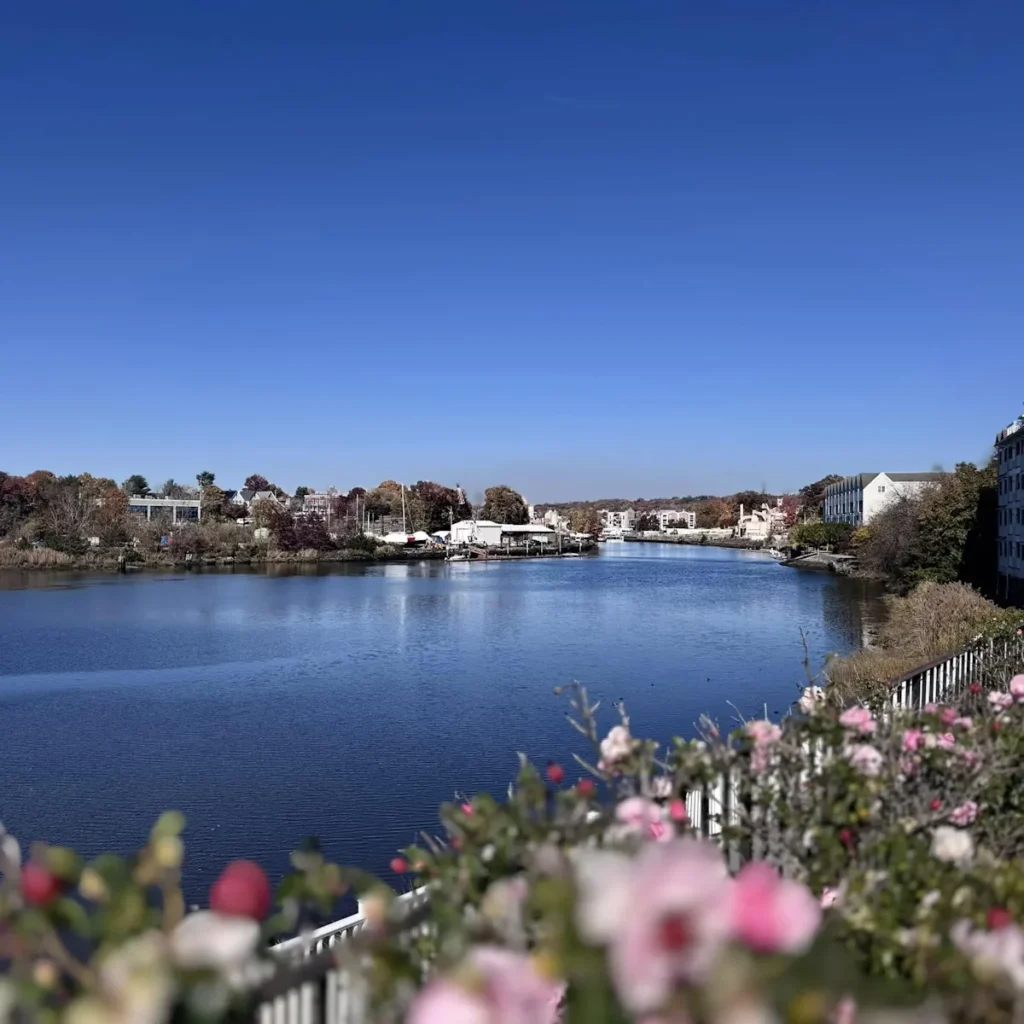
Th
e City’s Ad Hoc Affordable Housing Committee of the Common Council has been a very active group, preemptively
pushing the action of the AHAP forward. In January, the Committee invited a guest speaker on
Community Land Trusts to its meeting, and they plan to have a guest speaker in the future on tax incentives. Tentative guest speaker on
tax incentives.
The Committee was instrumental in establishing the City’s
Affordable Housing Account, which is to be used for the construction of affordable housing.
The City has also developed an “affordable housing tracker” that will help with administering and monitoring the process of all the action items in the AHAP. For more information about the affordable housing tracker, please contact the
Planning and Zoning Office for questions.
What’s Next? A Vision for Inclusive Growth
In addition to tasks Norwalk has already kick-started, the next steps focus on expanding affordable housing options while fostering community engagement. The top five high-priority initiatives include:
- Continuing to expand inclusionary zoning provisions to further incentivize the development of affordable and moderate-income housing units, including two-bedroom and family-sized units, which are in high demand. Incentives could include increased density bonuses, increased maximum height, and financial incentives, such as fee waivers and tax abatements.
- Evaluating City parcels for potential affordability housing projects.
- Developing a program to preserve and update “naturally affordable” units in exchange for deed restricted affordable units.
- Evaluating an affordable housing property tax incentive for qualified affordable housing units.
- Advocating for more government funding for public and affordable housing.
The City recognizes that homeownership is a crucial component of long-term affordability, with several key goals in mind. These include exploring opportunities for new low-interest or forgivable loan programs to provide financial assistance for affordable housing developers, rehabilitating naturally affordable units, and providing financial assistance to first-time homebuyers who meet income eligibility guidelines.
The City is exploring
“missing middle” housing—multi-unit dwellings like duplexes and townhomes that bridge the gap between single-family homes and large apartment complexes. These housing types are crucial for creating walkable neighborhoods and providing affordable options for middle-income residents.
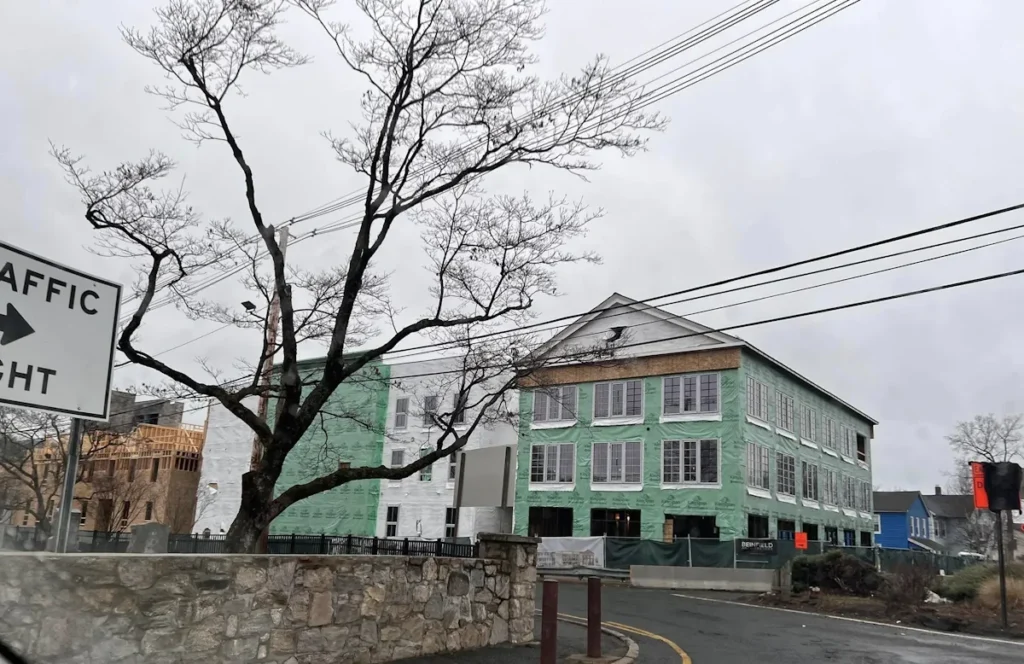
Spotlight on Accessibility and Equity
Ensuring equitable access to affordable housing remains a top priority.
The Fair Housing Advisory Commission plays an essential role in promoting transparency and inclusivity in all city-led initiatives. By addressing barriers related to race, disability, income, and family status, the commission helps build trust within the community.
The Norwalk Redevelopment Agency also supports this mission by utilizing grants that preserve naturally affordable housing units, ensuring long-term affordability for residents.
More Than Housing: Enhancing Livability, Workability, and Appeal
Norwalk’s housing strategy isn’t just about shelter—it’s about shaping the future of the City. The plan ties directly into larger equity and economic vitality goals by creating a diverse housing stock that accommodates the needs of its diverse population.
Norwalk’s approach aligns with its vision of becoming an inclusive, sustainable, and economically vibrant city. A diverse and affordable housing stock supports local employers, reduces commute times, and attracts a vibrant workforce,
enhancing the City’s workability and visitor appeal.
From zoning to state-level advocacy, the City of Norwalk is positioning itself as a leader in comprehensive community development.
Building a Better Norwalk, Together
Norwalk’s journey toward affordable housing is far from over. The City invites residents to participate in shaping its future through forums and discussions, which
anyone can attend here.
Together, we will build a Norwalk where everyone has the opportunity to thrive. Stay informed about upcoming initiatives by visiting
Norwalk Tomorrow’s website and subscribing to our Newsletter.
Top Ten Things That Attract People to Norwalk, CT
Choosing where to live or visit is a big decision, and Norwalk, Connecticut, consistently stands out as a premier choice. With a vibrant mix of coastal charm, rich history, diverse dining, and family-friendly attractions, it's no wonder CT Insider, Fortune Magazine, and Livability have named
Norwalk, CT, a top city to live in.
So whether you're seeking a weekend getaway or considering a new place to call home, Norwalk has something for everyone.

1. Safety and Quality of Life
Safety is a key factor when choosing where to live or visit. Norwalk boasts a crime rate significantly lower than the national average, making it a secure place to explore and raise a family.
The Norwalk Police Department's community policing programs have been instrumental in maintaining safe neighborhoods.
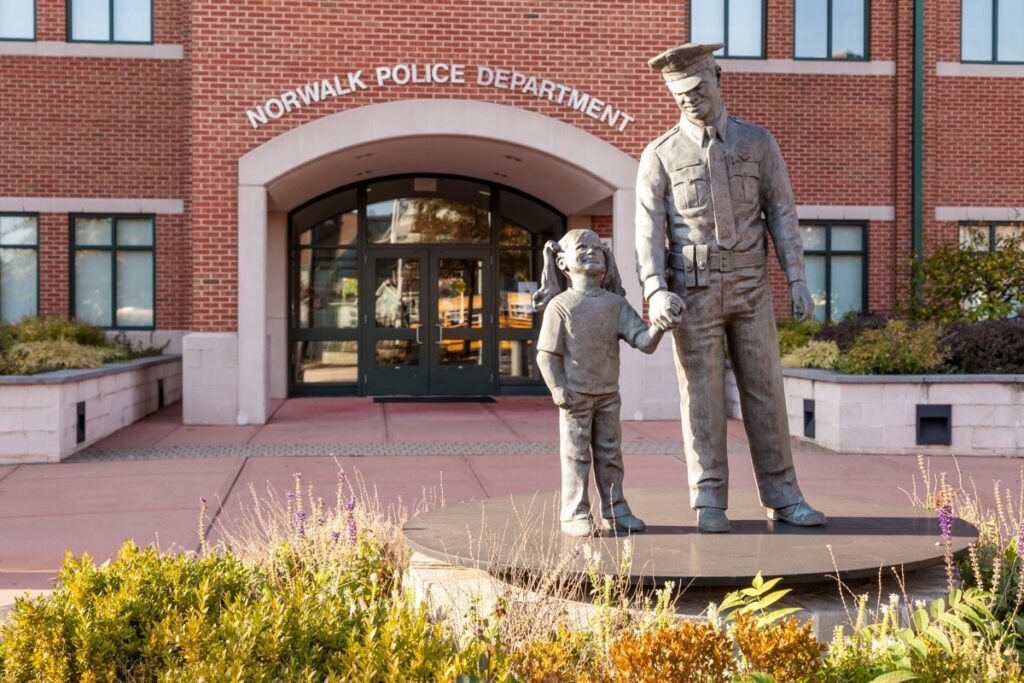
2. Access to Great Jobs and Economic Opportunities
Norwalk's economy thrives with a mix of Fortune 500 companies, local businesses, and innovative startups. The city's proximity to New York City and access to robust infrastructure attract professionals across sectors. Major employers include
Booking Holdings,
Xerox Corporation, and a bustling retail and service industry.
Norwalk, a city built on diversity and local business, is also proud of its
Small Business and Main Street Program. Norwalk has become a source of innovation, inspiration and a desirable destination for
new and developing businesses founded by creative thinkers and doers. For entrepreneurs, Norwalk offers resources through the
Greater Norwalk Chamber of Commerce and the
Business Development Center to support small business growth.
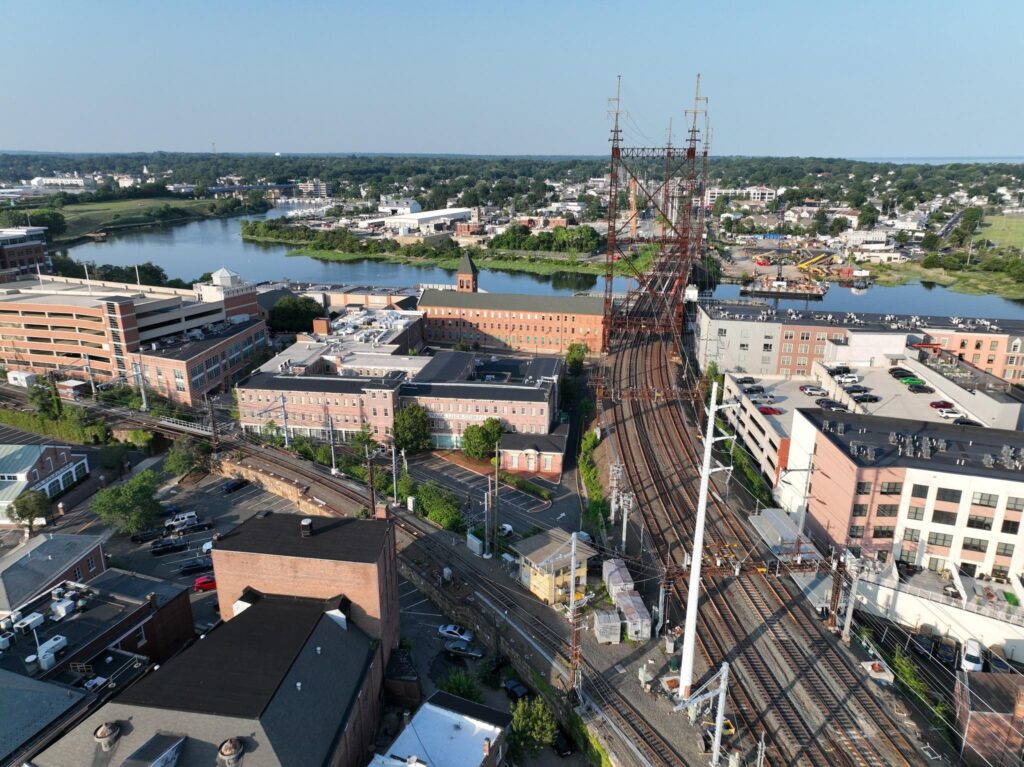
3. Abundant Open Spaces and Waterfront Areas
Outdoor lovers flock to Norwalk's extensive parks and beaches. Calf Pasture Beach, with its sweeping views of Long Island Sound, is perfect for sunbathing, kayaking, or a family picnic. Cranbury Park offers hiking trails and dog-friendly areas, while Veterans Memorial Park features a marina and walking paths. Explore the scenic
Norwalk River Valley Trail (NRVT), an expanding network of multi-use trails for biking and walking.
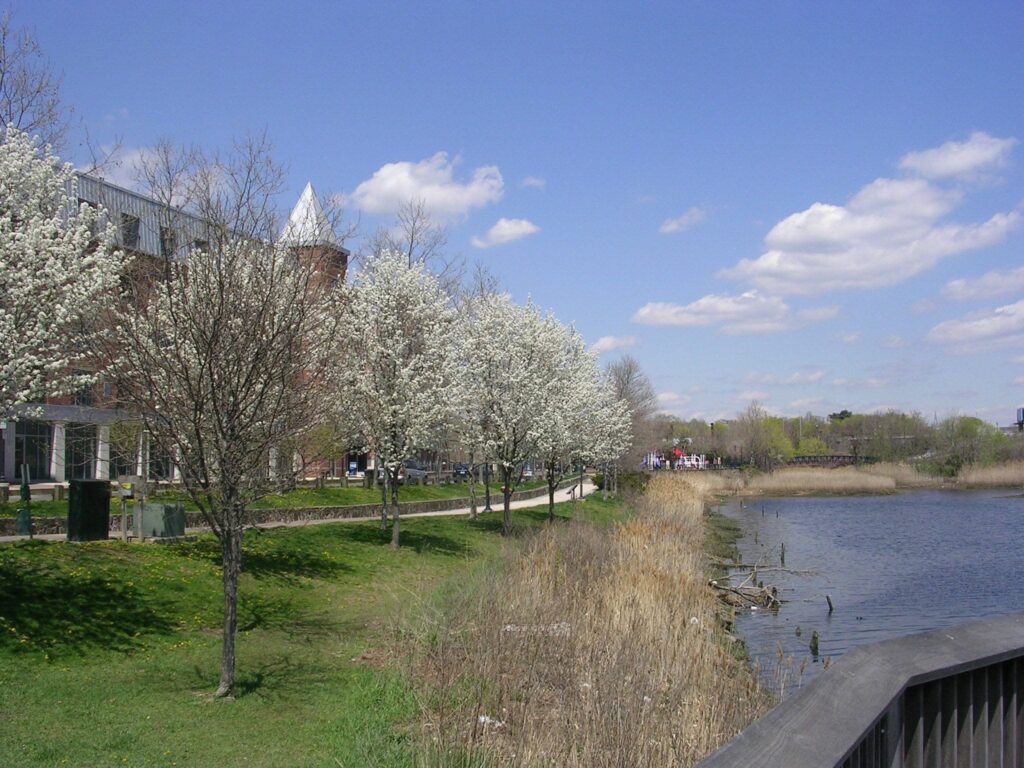
4. Cultural Attractions and the Arts Scene
Norwalk's cultural vibrancy is evident in its numerous arts venues and festivals. The Wall Street Theater hosts concerts, plays, and comedy shows, while the Rowayton Arts Center and Maritime Garage Gallery showcase local talent. Each August, the
SoNo Arts Festival fills the streets with art, music, and the whimsical Puppet Parade. For classical music enthusiasts, the
Norwalk Symphony Orchestra delivers performances year-round.
5. Unique Attractions: Maritime Aquarium and Lockwood-Mathews Mansion Museum
No visit to Norwalk is complete without a trip to the
Maritime Aquarium. With over 2,700 marine animals, interactive exhibits, and a 4D theater, it's a must-see for families and marine life enthusiasts. History buffs will love touring the
Lockwood-Mathews Mansion Museum, a Gilded Age masterpiece featuring grand architecture and rotating historical exhibits.
[caption id="attachment_2419" align="aligncenter" width="1024"]
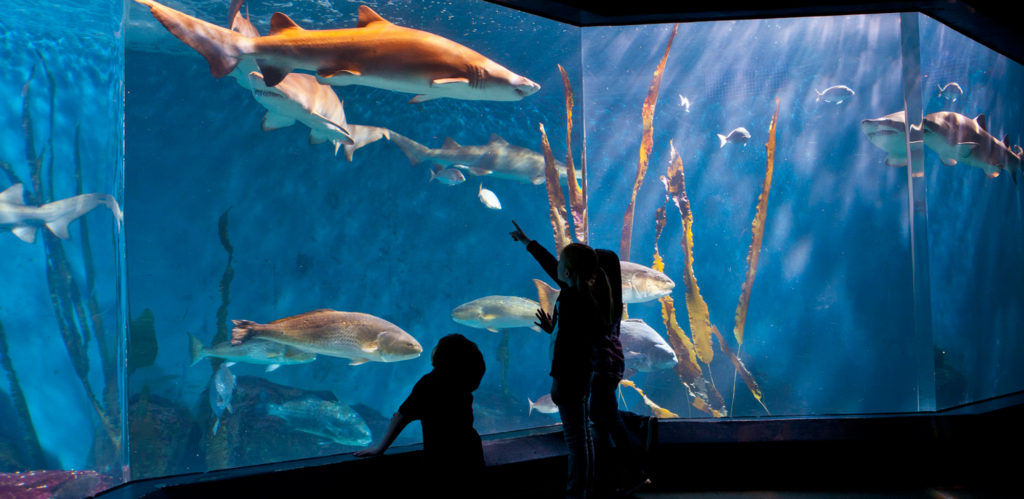
Photo Credit: Visit Norwalk[/caption]
6. Year-Round Events and Festivals
Norwalk's events calendar is packed with festivities that attract visitors year-round. The Norwalk Oyster Festival each September celebrates the city's maritime heritage with live music, carnival rides, and an abundance of seafood hosted by the
Norwalk Seaport Association. Seasonal highlights include Norwalk Earth Day, Pride in the Park, the SONO Arts Festival, the Norwalk NICE Festival, Halloween Nightfair, and the Winter Holiday Tree Lighting Ceremony. Visit the
Norwalk Events Calendar for a complete list of activities.
[caption id="attachment_2420" align="aligncenter" width="1025"]
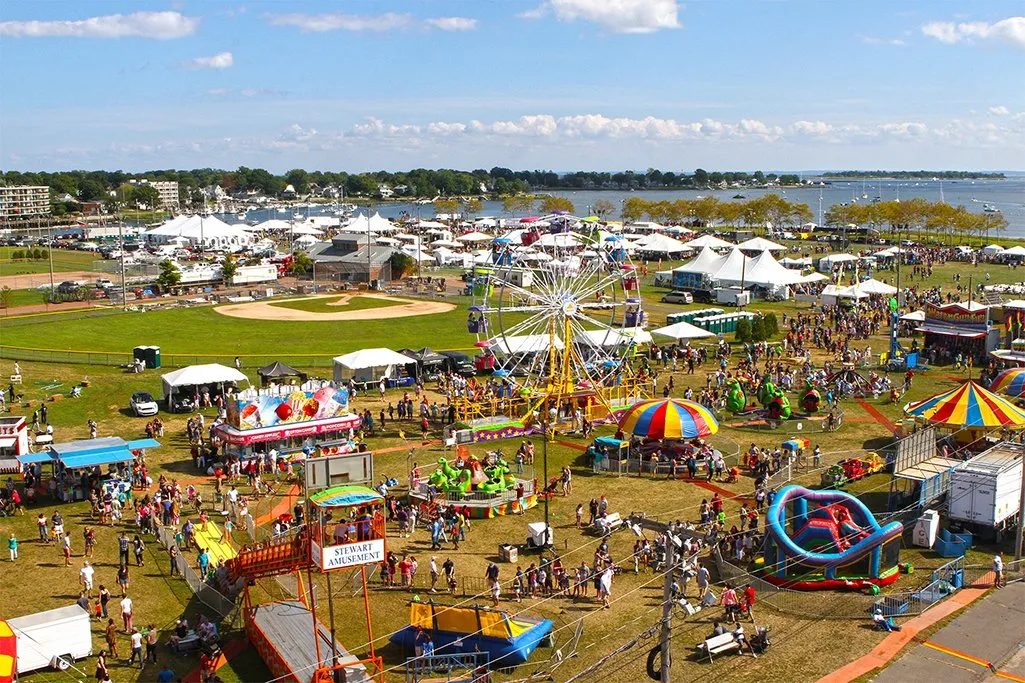
Photo Credit: Norwalk Seaport Association[/caption]
7. Diverse Culinary Scene and Local Breweries
Foodies will find plenty to savor in Norwalk's vibrant dining scene. South Norwalk (SONO) offers everything from fresh seafood at Sono Seafood to innovative farm-to-table dishes at Washington Prime. Beer lovers can unwind at local breweries like
Spacecat Brewing Company and East Rock Brewing Company. With 28 restaurants recognized by
Connecticut Magazine's Best Restaurants 2025, there's no shortage of top-tier dining experiences.
8. Transportation and Mobility Options
Conveniently located along the I-95 corridor and the Merritt Parkway, Norwalk offers easy access to neighboring cities and New York City. The
Metro-North Railroad's New Haven Line provides frequent, affordable trains for commuters and travelers. Residents value the city's commitment to pedestrian and bike-friendly infrastructure, with ongoing efforts to expand bike lanes and improve walkability.
For those driving into the city,
Park Norwalk manages several convenient parking garages and lots, including the Haviland Deck, North Water Street Lot, and Webster Lot. These facilities offer affordable daily rates and monthly permits, providing easy access to popular destinations like the SONO district and Maritime Aquarium.
Pedestrians and cyclists also benefit from Norwalk's growing infrastructure.
The Transportation, Mobility, and Parking (TMP) department actively works on expanding bike lanes and improving sidewalk accessibility. Whether you prefer to drive, bike, walk, or take public transportation, Norwalk’s diverse mobility options make getting around town convenient, safe, and environmentally friendly.

9. Top-Rated Schools and Libraries
Education is a priority in Norwalk, home to 22 primary and secondary schools, including highly regarded magnet programs and private institutions.
CT State Community College Norwalk, previously known as Norwalk Community College, is renowned for its academic and vocational programs. Public libraries like the
Norwalk Public Library and
Rowayton Library provide invaluable resources, free programs, and community spaces.
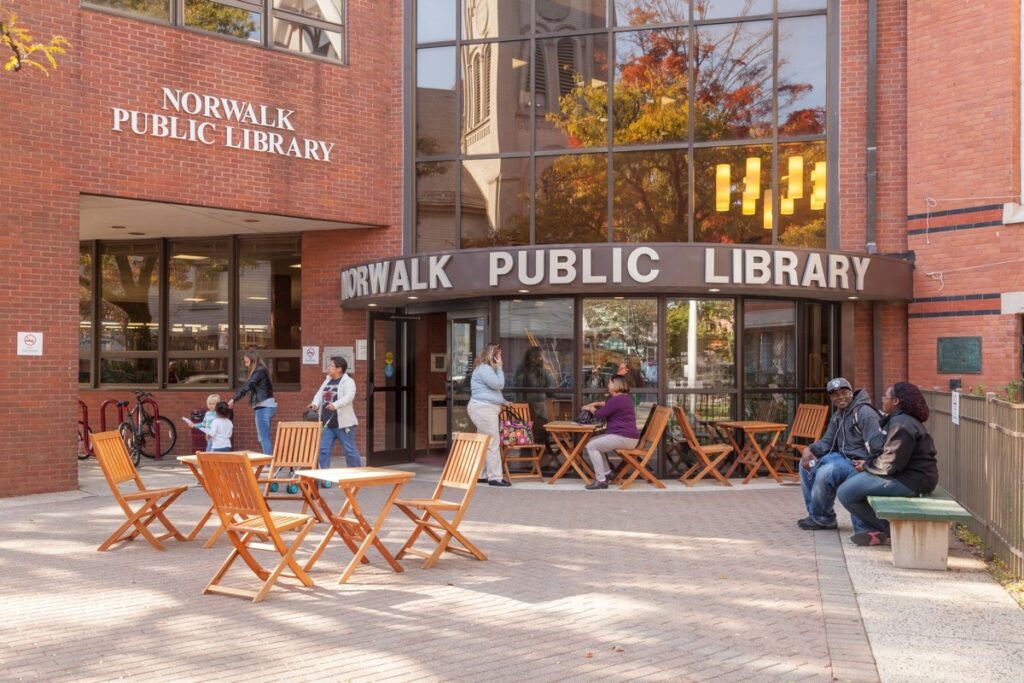
10. Engaging Community and Quality Infrastructure
Norwalk's well-maintained roads, bridges, and utilities contribute to its high quality of life. Residents enjoy a strong sense of community through active neighborhood associations, sports leagues, and volunteer opportunities. The city's investment in infrastructure ensures smooth transportation and economic development.
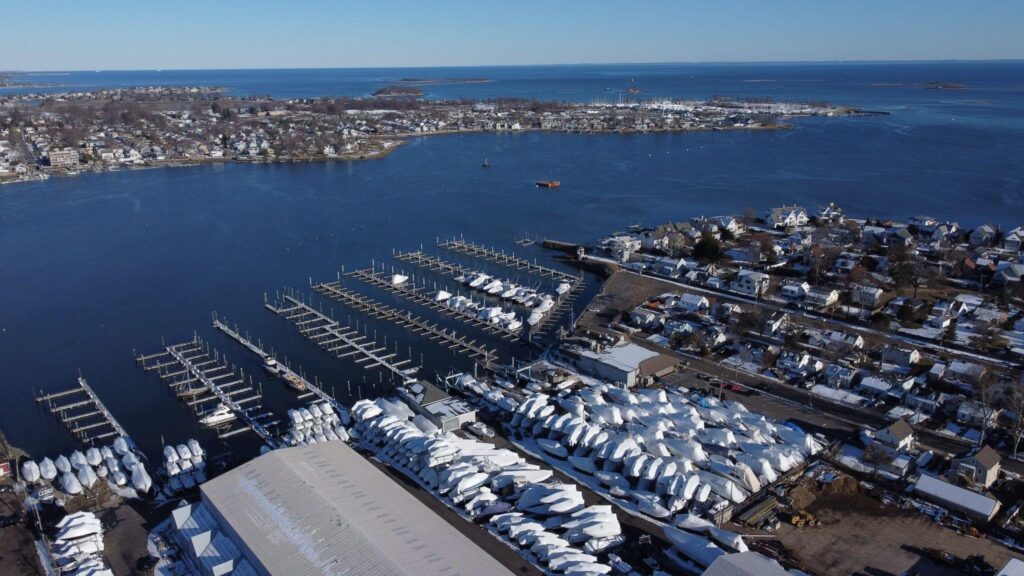
Plan Your Trip to Norwalk Today!
Whether you're visiting for the weekend or considering a permanent move, Norwalk, Connecticut has something to offer everyone.
Subscribe to our newsletter below for the latest news and updates from Norwalk Tomorrow!
Spotlight on Norwalk's Historic Districts
A historic district is a locally, state, and/or nationally recognized area of culturally and architecturally significant buildings. These buildings are usually at least 50 years old, contain many original features, and are often associated with important people, events, or architectural styles.
First incorporated as a town in 1651 and later as a city in 1893, the City of Norwalk was known for its booming oyster farming industry. Today, Norwalk’s many historic districts help to preserve its cultural and architectural legacy.
Nationally-Recognized Historic Districts
[caption id="attachment_2386" align="aligncenter" width="720"]

Photo Credit: Mike Mushak[/caption]
Five Mile River Landing Historic District: Listed in 2009, this 7.2-acre district features Greek Revival, Federal, and Late Gothic Revival buildings.
Haviland and Elizabeth Streets-Hanford Place Historic District: Listed in 1988, this 4.2-acre district features buildings in Italianate, Second Empire and Queen Anne styles.
Norwalk Green Historic District: Listed in 1987, this 35-acre district features a variety of historically significant architectural styles including Colonial, Greek Revival, Second Empire, Federal, Italianate, Colonial Revival, American Four-Square, Queen Anne, Bungalow, Shingle, Stick, Georgian Revival and Gothic Revival.
Rowayton Depot Historic District: Listed in 2019, this 68-acre district features historically significant architecture, community planning and development, and transportation features.
Silvermine Center Historic District: Listed in 2009, this 100-acre district features buildings in Federal, Colonial, Greek Revival, Queen Anne, and Colonial Revival styles.
[caption id="attachment_2389" align="aligncenter" width="720"]

Photo Credit: Connecticut Historical Commission[/caption]
South Main and Washington Streets Historic District: Also known as the SoNo Historic District, this 5.5-acre district, featuring historically significant homes, businesses, and a theater, was first recognized in 1977.
The Lodges Historic District: Located at 68 and 70 South Main Street, this small historic district was designated in 2020 due to its cultural significance. These buildings served as social meeting halls for two fraternal orders, the Loyal Order of Moose and the Independent Order of Odd Fellows.
Verneur Pratt Historic District: Listed in 2011, this 2.8-acre district was once home to Verneur Edmund Pratt, who invented the optigraph, an early microfilm reader.
Wall Street Historic District: Recognized in 2009, this 5.7-acre district features buildings from Italianate, Romanesque, Spanish Colonial Revival, Classical Revival, and Moderne styles.
[caption id="attachment_2390" align="aligncenter" width="720"]
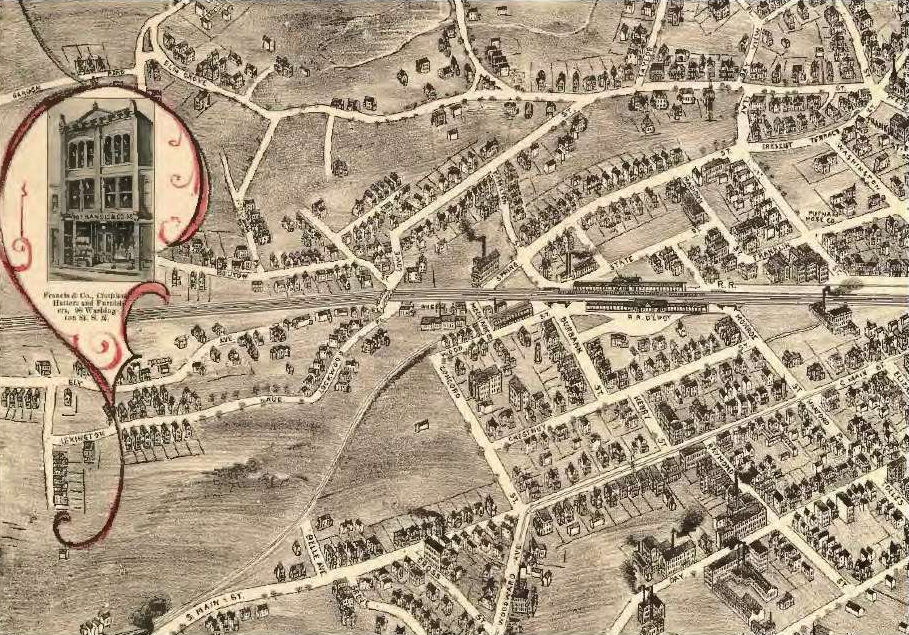
Photo Credit: The Cecil Group for the Norwalk Redevelopment Agency[/caption]
Whistleville Historic District: Listed in 2021, this district encompasses an 84-acre area around the South Norwalk train station. The railroad played a pivotal role in the city’s history as a distribution center for commerce. Historically home to immigrants from Hungary and Italy who worked in the city’s factories, the Whistleville Historic District features many historically significant homes and two churches.
Village Creek Historic District: Established in 1949 as one of the first racially integrated planned communities in the U.S., Village Creek is a 37-acre neighborhood featuring Modernist architecture and shared open spaces like a marina, playground, and private beach. Designed with a commitment to inclusivity, the community overcame early real estate and financial barriers, maintaining its distinct mid-century character and social progressivism.
Oysterman’s Row Historic District: Located along the Five Mile River, this district is known for its collection of 18th and 19th-century homes, which reflect the architectural styles of the period, including Colonial, Federal, and Greek Revival. These homes, originally built by sea captains and merchants, tell the story of Norwalk’s once-thriving shipbuilding and trading economy. The river provided ideal conditions for oyster farming, an industry that shaped the local economy and community identity for generations.
[caption id="attachment_2391" align="aligncenter" width="723"]

Photo Credit: Connecticut Historical Commission[/caption]
State-Recognized Historic Districts
- West Main Street Historic District: Listed in 2005
- Pudding Lane Historic District: Listed in 2005
- Camp Street Historic District: Listed in 2007
In addition to historic districts, the City of Norwalk is home to several significant landmarks.
National Historic Landmark: Lockwood-Mathews Mansion Museum
A stunning example of Second Empire architecture, this National Historic Landmark represents 19th-century wealth and innovation. Considered one of the earliest and most significant examples of a Second Empire home in the nation, the Lockwood-Mathews Mansion was built from 1864-1868 by railroad tycoon LeGrand Lockwood.
Well ahead of its time, the mansion featured indoor hot and cold plumbing, gas lighting, ventilation, and a central heating system that burned a ton of coal a day. Later owned by the Mathews family, the estate was sold to the city of Norwalk in 1941. The mansion became a National Historic Landmark in 1971, after a group of local preservationists saved the building from demolition.
Mill Hill Historic Park
Overseen by the Norwalk Historical Society, Mill Hill Historic Park is home to several historic buildings. The Norwalk Town House, built in 1835, served as the town’s gathering place and administration building. The Governor Fitch Law Office, c. 1740, was once part of Governor Thomas Fitch’s home. It has been reconstructed at Mill Hill as a law office.
The Downtown District School House, built in 1826, was a school until 1871. A century later, it was relocated to Mill Hill and restored. Also included in the park is Norwalk’s third oldest cemetery, the Mill Hill Burying Ground; a building from A. E. Smith & Sons Pottery Company, known as The Lockup; and a barn from 1880.
The park grounds are open year-round, from sunrise to sunset. The historic buildings are open during special events and by appointment for group tours, which are offered from May - September.
[caption id="attachment_2392" align="aligncenter" width="720"]

Photo Credit: Norwalk Earth Day 2024[/caption]
The Norwalk Green
Norwalk Green is a public gathering place that dates back to the 1600s. Each year, a Summer Concert Series and Annual Holiday Tree Lighting are held in the park. Norwalk Green can also be rented for private events.
Overlooking the Green are two historic churches, St. Paul’s Episcopal Church (c. 1930) and the First Congregational Church (c. 1917). The churches hold seasonal farmers' markets.
Adaptive Reuse
[caption id="attachment_2398" align="aligncenter" width="772"]
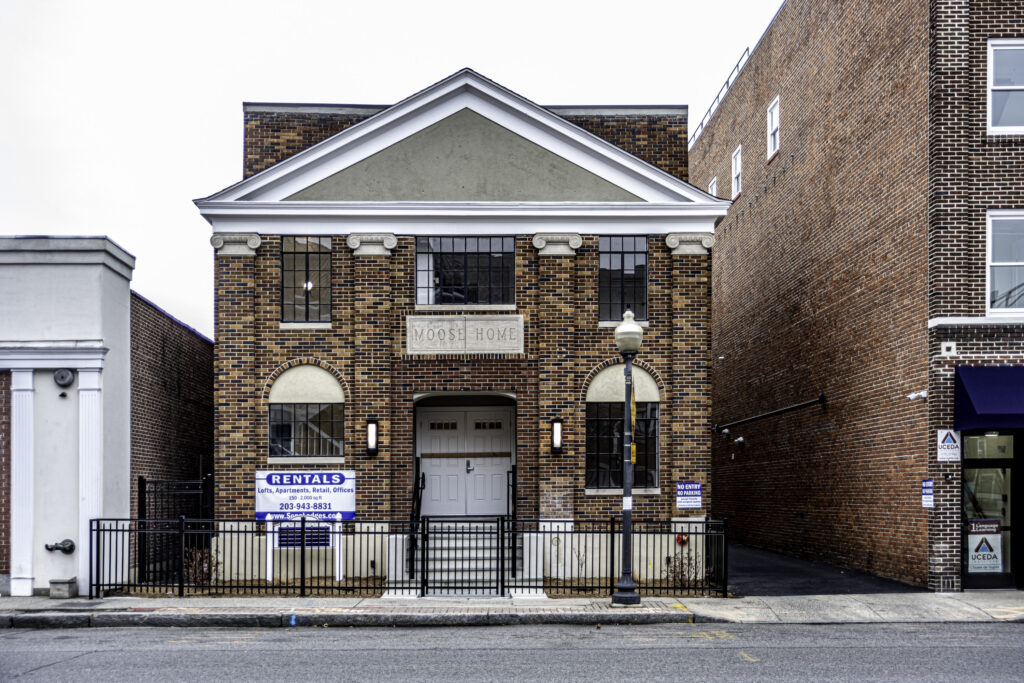
Photo Credit: Tod Bryant[/caption]
Not all historic buildings become museums. In the SoNo community, there are many great examples of adaptive reuse of historic buildings. The Maritime Aquarium was once an abandoned ironworks factory from the 1860s. The SoNo Lodges, featuring lofts, apartments, and workspaces, were once social meeting halls for two fraternal orders, the Loyal Order of Moose and the Independent Order of Odd Fellows. The Brim & Crown apartments were once the Hat Corporation factory from 1929 and Shirt Factory Lofts were once the Le Roy Shirt Factory from 1921.
Preservation Efforts in Norwalk
Maintaining Norwalk’s historic character is a community effort. Local government, non-profit organizations and residents alike all play a role in preserving the city’s history. Some key players in this effort include:
Norwalk Historical Society: A non-profit organization incorporated in 1899 to research, preserve, and promote interest in the history of Norwalk, the Historical Society’s educational exhibits, programs and lectures highlight Norwalk’s rich history and diversity. The Norwalk Historical Society manages and operates the Norwalk Historical Society Museum and Mill Hill Historic Park.
Norwalk Preservation Trust: Founded in 2003, Norwalk Preservation Trust is a non-profit organization that advocates for Norwalk’s architectural heritage and serves as a preservation resource for property owners, residents, and developers, as well as other organizations and government agencies.
Historic Facade Improvement Grant Program: This program provides financial assistance for restoring and maintaining the exterior facades of historic buildings.
Learn more here.
Historic Preservation Regulations: These approved regulations aim to further protect Norwalk’s historic structures and districts.
View pages 314-315 in article 4 here.
Norwalk Preservation Trust
The Norwalk Preservation Trust has been working to preserve Norwalk’s historic buildings and neighborhoods, the architectural legacy, since 2002. The Preservation Trust works with homeowners, developers, and business owners, as well as state and local governments, to provide advice and support on historic preservation issues. The efforts have supported an update of the Norwalk Historic Resource Inventory and some of the historic preservation elements of Norwalk’s Plan of Conservation and Development. The Trust worked to establish Norwalk’s demolition delay ordinance to allow property owners time to consider preservation over demolition, and the Norwalk Trust has invoked that ordinance when necessary. The Norwalk Preservation Trust have led 13 tours of Norwalk’s historic buildings and sponsored many lectures and workshops. These efforts and others have earned NPT recognition and awards from the U.S. Congress, the Connecticut General Assembly, the Governor of Connecticut, Preservation Connecticut, and the City of Norwalk. NPT is always looking for volunteers, members, and even those willing to serve on the Board of Directors. To learn more about NPT and how to support historic preservation in Norwalk,
visit thier website.
Why It Matters
“Norwalk is a very old city, but little remains of our early history. What is left of our historic buildings, neighborhoods and streetscapes tell the story of the last three and a half centuries of our city and its residents. Streets lined with old buildings, or even a single charismatic house, are the soul of a community. When we have been away, they welcome us back and let us know that we’re home. They hold stories that most of us will never know, but their presence alone speaks to us of place and community. The more of these buildings we lose, the more we lose what makes Norwalk - Norwalk.” — Tod Bryant, President of the Norwalk Preservation Trust.
What You Can Do
- Join and support the Norwalk Preservation Trust, the Norwalk Historical Society or Historic Rowayton
- Have your historic house plaqued by the Norwalk Historical Society
- Join or follow online Preservation Connecticut, statewide historic preservation nonprofit, Connecticut Preservation Action, a statewide lobbying nonprofit with a Have your historic house plaqued by the Norwalk Historical Society and the National Trust for Historic Preservation, The National Historic Preservation Organization
- Follow the news of historic preservation-related topics and support them.
Stay Connected & Support Historic Norwalk
Norwalk’s historic districts and landmarks tell the story of our city’s past while shaping our future. By preserving these sites, we ensure that future generations can appreciate Norwalk’s architectural and cultural heritage.
Want to stay updated on preservation efforts, historic events, and volunteer opportunities?
Sign up in the footer below for updates from Norwalk Tomorrow and be part of the movement to protect our city’s history!Public Art in Norwalk: A Catalyst for Economic Development and Community Engagement
Norwalk, Connecticut, has long been a hub of creativity and culture, but recent developments have solidified its status as a premier arts destination. The city's commitment to public art has beautified its streets and public spaces and become a driving force for economic development and community engagement.
From murals to art galleries, Norwalk’s public art initiatives breathe life into its streets, foster community pride, and contribute to a thriving local economy. This commitment ensures that residents and visitors alike can experience the city’s cultural richness firsthand.
[caption id="attachment_2377" align="aligncenter" width="1024"]

Photo Credit: The Norwalk Hour[/caption]
Norwalk’s Commitment to Public Art
In a significant milestone,
the Connecticut Office of the Arts (COA) recently designated Norwalk an Arts and Cultural District. This recognition highlights the city's dedication to fostering creativity, community engagement, and economic growth through the arts. Mayor Harry Rilling, alongside local, state, and community leaders, celebrated this achievement, emphasizing Norwalk's vibrant and thriving artistic community.
Recent Public Art Installations in Norwalk
"Welcome to Norwalk" Mural
The stunning "Welcome to Norwalk" mural on West Avenue is the crowning jewel of Norwalk's recent artistic endeavors.
Stretching an impressive 1,050 feet by 20 feet, this massive artwork serves as a colorful gateway to the city.
The mural features:
- A striking humpback whale as the centerpiece
- Local marine life, including harbor seals, jellyfish, and oysters
- Native birds such as cardinals and red-winged blackbirds
- New England wildlife, including the cottontail rabbit
Created by internationally renowned artists Sonny Behan and Ernesto Maranje, with assistance from five local artists, the mural was completed in just one month. This collaborative effort reflects Norwalk's commitment to involving both global talent and local creativity in its public art initiatives.
Other Notable Installations
Norwalk's public art scene extends beyond this monumental mural:
- Monroe Street Murals: Underneath the train track bridge, the stunning mural by Rough Edge Collective, formed by Maria-Jose (MJ) Lindo-Lawyer and Joshua Lawyer, adds a dynamic touch to Norwalk’s growing public art portfolio. MJ and Joshua bring their unique backgrounds—shaped by the Nicaraguan civil war and Bay Area graffiti culture—to this powerful work. The Monroe Street mural aims to evoke strength and inspire exploration, transforming a once-overlooked space into a symbol of creativity and resilience.
Economic and Social Impacts
Public art serves as more than just visual decoration—it’s a catalyst for economic development and community engagement. In Norwalk, the impacts of public art are clear:
Attracting Visitors and New Residents
Public art draws tourists and potential new residents eager to explore Norwalk’s unique cultural offerings. High-quality art installations create memorable experiences and boost local tourism by encouraging visitors to dine, shop, and stay in the area. The city's vibrant art scene has become a magnet for visitors and potential new residents, drawn by the unique blend of creativity and community spirit.
Enhancing Community Pride and Identity
Public art installations, particularly the "Welcome to Norwalk" mural, have become sources of civic pride. Common Council Member
Josh Goldstein remarked that the mural is "colorful and welcome and thoughtful and exciting," embodying Norwalk's values and identity.
[caption id="attachment_2376" align="alignleft" width="595"]

Photo Credit: The Monster Studio[/caption]
Supporting Local Artists and Businesses
Public art initiatives provide opportunities for local artists to showcase their work while creating economic benefits for nearby businesses. Cafes, restaurants, and shops located near murals or galleries often see increased foot traffic and patronage as visitors explore the area.
"Public art in Norwalk is not just about aesthetics; it's about fostering a sense of belonging, supporting our local economy, and elevating the voices of our artists," said Sabrina Godeski, Norwalk's Business Development & Tourism Director and staff to the Arts and Culture Commission. "When residents and visitors interact with these pieces, it strengthens our identity as a creative and connected community."
Norwalk's Rich Artistic Heritage
Public art is not a new phenomenon in Norwalk—the city has a longstanding tradition of integrating art into its public spaces.
One of the most notable examples is the collection of WPA murals at Norwalk City Hall. Created during the New Deal era, these murals tell stories of Norwalk’s history and people, serving as a bridge between the past and present.
In recent years, Norwalk has invested in preservation and restoration efforts to maintain these historic works. This ongoing commitment ensures that future generations can continue to appreciate and learn from the city’s artistic legacy.
"Norwalk’s investment in preserving its artistic heritage while creating new opportunities for public art reflects our dedication to both honoring the past and embracing the future," added Godeski. "Art connects people across generations, and that connection is at the heart of our community."
WPA Murals at Norwalk City Hall
The city boasts one of the largest and most significant collections of restored Depression-era art in the country. These WPA murals, created as part of President Franklin D. Roosevelt's New Deal in the 1930s, stand as a testament to the enduring power of art in times of adversity.
Ongoing Preservation Efforts
Norwalk continues to invest in preserving and restoring these historical artworks, ensuring that future generations can appreciate the city's artistic legacy.
The city plans to strengthen its partnerships with local artists, community members, and cultural organizations to develop new public art projects.
The Norwalk Arts and Cultural Commission is dedicated to commissioning new works that reflect Norwalk's evolving culture and diversity.
Norwalk's Bright Future as an Arts Destination
As Norwalk embraces its identity as an arts hub, the future looks bright for this Connecticut city. The combination of historical treasures like the WPA murals and contemporary masterpieces like the "Welcome to Norwalk" mural creates a rich tapestry of artistic expression that spans generations.
The city's commitment to public art goes beyond mere decoration; it's a strategic investment in community building, economic development, and cultural enrichment. By transforming public spaces into open-air galleries, Norwalk invites residents and visitors alike to engage with art in their daily lives, fostering a sense of connection and pride in the community.
As Mayor Rilling aptly put it, Norwalk is truly a "vibrant and thriving community," especially for those who appreciate the arts. With its newly minted status as an Arts and Cultural District and a clear vision for the future, Norwalk is poised to become a beacon for artists, art lovers, and cultural enthusiasts from across the region and beyond.
[caption id="attachment_2375" align="aligncenter" width="1024"]
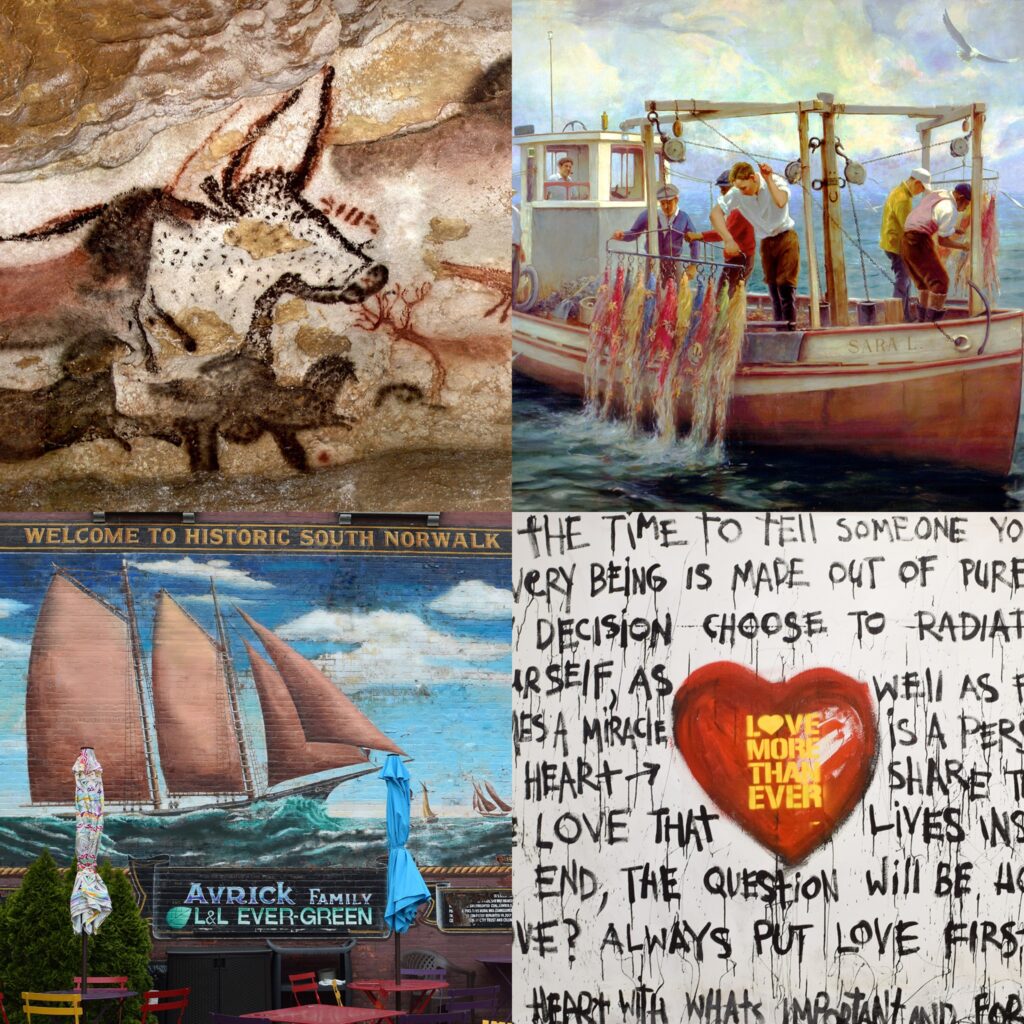
Photo Credit: Norwalk Arts & Culture Commission[/caption]
Manresa Island Transformation: Norwalk's Exciting New Waterfront Destination
[caption id="attachment_2367" align="aligncenter" width="1024"]
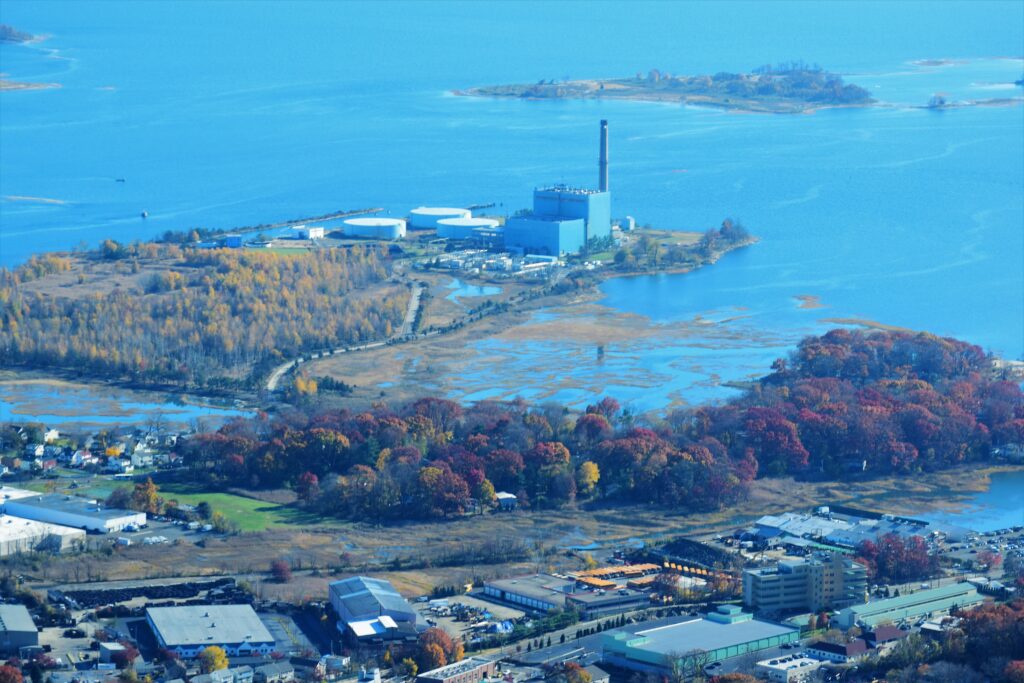
Photo Credit: Geoffrey Steadman[/caption]
Nestled along Norwalk's coastline, Manresa Island stands as a testament to Connecticut's industrial past and a beacon of its sustainable future. This 144-acre property, once home to a power plant, is now poised for an exciting transformation that promises to reshape the landscape and enrich the community.
The long-awaited transformation of Manresa Island is finally taking shape. This ambitious project promises to turn a former industrial site into a stunning public park and community hub that will redefine our city's waterfront.
Local philanthropists Austin and Allison McChord have purchased the 125-acre brownfield site for $40 million, with plans to develop it as a gift to their hometown. This generous initiative ensures that Manresa Island will become a cherished public space for generations to come.
Historical Context
For over half a century, Manresa Island played a crucial role in powering the region. The site's journey began in 1960 with a coal-fired plant, later transitioning to oil in 1972. However, Hurricane Sandy's storm surge inundated the site in 2012, leading to the plant's closure in 2013. This event marked the beginning of a new era for Manresa Island.
The Manresa Association, formed in 2013, has been at the forefront of advocacy for the island's future. With over 900 households and several local organizations as members, the association has been instrumental in shaping the vision for Manresa.
Find more information on our Manresa Island Plan.
[caption id="attachment_2368" align="aligncenter" width="1024"]

Photo Credit: Geoffrey Steadman[/caption]
Collaborative Study
In 2017, a groundbreaking partnership between the Manresa Association and the City of Norwalk initiated a comprehensive study. This collaborative effort aimed to:
- Identify potential future uses for the property
- Assess the economic impact of various development scenarios
- Engage key stakeholders, including city departments and NRG Energy (the plant's owner)
Environmental Considerations
The study provided crucial insights into:
- Current environmental and ecological conditions
- Ongoing and planned remediation efforts
- Potential approaches for further environmental restoration
Looking Ahead
As Norwalk envisions the future of Manresa Island, the focus remains on:
- Ensuring environmental safety
- Preserving open spaces and conservation habitats
- Enhancing the physical beauty of Norwalk and the Long Island Sound coastline
[caption id="attachment_2369" align="aligncenter" width="1024"]

Photo Credit: Geoffrey Steadman[/caption]
Get Involved
The transformation of Manresa Island is an ongoing process that will shape Norwalk's future. Stay informed and contribute to this exciting project by:
- Attending a free tour of the island and building in 2025
- Joining the Manresa Association
- Participating in community discussions
Read on for more about the park design, and visit the park’s website for more information:
Manresaislandpark.orgWhat Are Accessory Dwelling Units and Does Connecticut Allow Them?
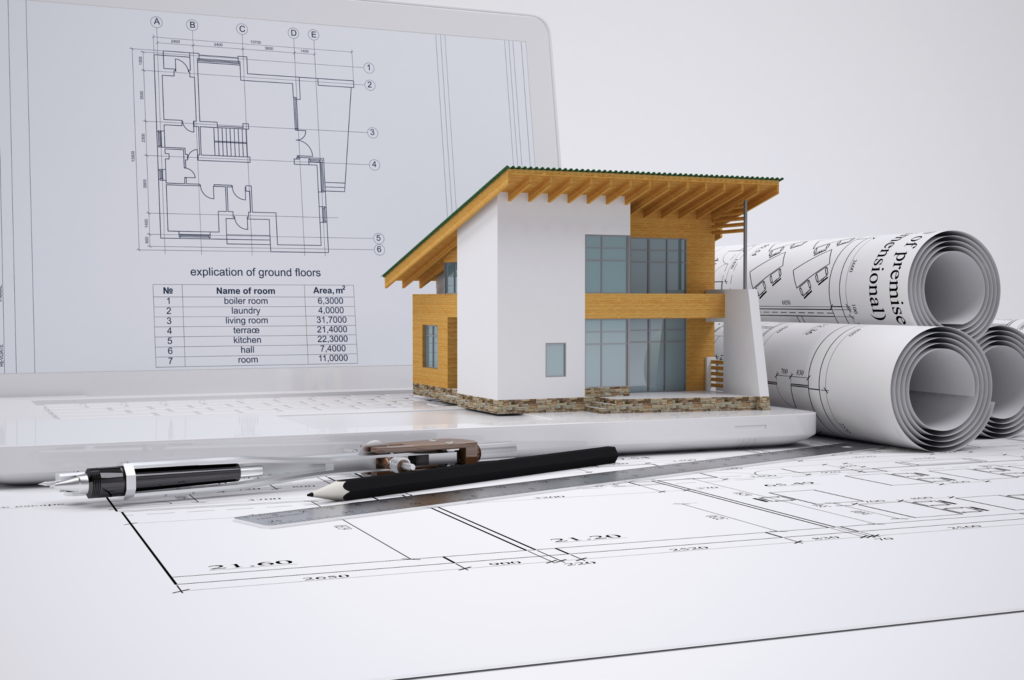
Families come in a variety of shapes and sizes. More younger family members are living at home for longer. Older family members are also beginning to move in with younger members to be taken care of or to help with childcare. Regardless of what your family looks like, it’s important to have enough space for everyone in your household.
Accessory dwelling units (ADU) are one way to add space to a single-family home. When considering adding on an ADU or rental property, there are a lot of things to think about. What exactly are ADUs, what benefits will it have on your home, and what are the laws about them in Connecticut?
What are Accessory Dwelling Units?
ADUs go by many names. Mother-in-law suites, backyard cottages, accessory apartments, and granny pods are just a few.
At their heart, ADUs are a second, smaller house or apartment that is either attached to or detached from the primary residence. For example, people often have an ADU in their basement or backyard. The size and location of ADUs on a property are typically determined by that municipality’s zoning regulations.
There will be a kitchen, bedroom, bathroom, and living room area. Each dwelling can be catered to a specific person or family size.
Building ADUs can vary in cost depending on where you build them and how big they are. Creating one in your existing house, like the basement, can be cheaper because you don’t have to deal with adding walls, foundations, or plumbing. If you build one detached from your home, you will have the added expense of new plumbing and electrical hookups, but it can be more customizable.
Benefits for Single Family Homes
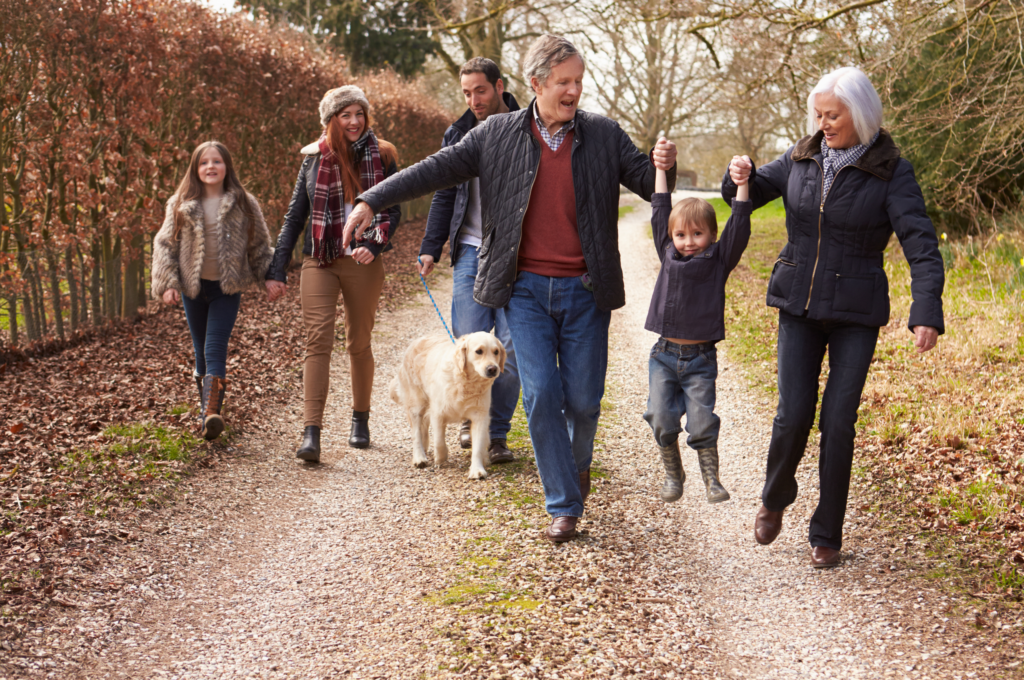
If you have a single-family home, it can be hard to house extra family members or children who need to live at home longer but want their own space. One of the biggest benefits of owning an ADU is that you create space for family members who need it.
Depending on the location of the dwelling, you can also rent it out to make extra income. ADUs can increase the value of your property by 20%-30%. It can also appeal to more buyers when you go to sell your home.
These dwellings can also help reduce gentrification and desegregate neighborhoods by giving opportunities to people who otherwise might not be able to afford to live in certain neighborhoods.
Accessory Dwelling Unit Laws in Connecticut
The laws around accessory dwellings in Connecticut changed in 2021. Public Act 21-29 legislation requires towns to designate specific zones where ADUs are permitted as-of-right, either attached to or detached from the single-family house.
However, towns can opt-out and set their own requirements for ADUs or not allow them at all. One exception to this is that towns cannot require a minimum square footage. Be sure to check your local requirements before building.
ADU Laws in Norwalk, Connecticut
In Norwalk, CT ADU regulations were adopted in 1982, with updates adopted by the Planning & Zoning Commission at their December 8, 2022 meeting. There are currently 259 accessory apartments in the city. After reviewing the new state laws, the Commission agreed with the majority of the new state law. In fact, many of Norwalk’s current ADU regulations already complied with the law, including:
- ADUs are permitted in all zones where the primary use of a property is a single-family residence
- ADUs are allowed to be attached to or within a single-family residence
- Setbacks and building frontage must be less than or equal to that required for single family residences
- No more than one parking space for an ADU
- A familial, marital, or employment relationship between the accessory apartment occupant and single family residence owners is not required
- Separately billed utilities are not required
The one area of concern for the Commission was the allowed height of a detached ADU, which the new state law requires to be the same as what is allowed for single-family houses. In Norwalk, the maximum allowable height for a detached ADU varies between 15’-20’, depending on the location of the detached ADU.
Additionally, the Norwalk Planning and Zoning Commission updated the design and landscape standards for ADUs, stating, “For detached accessory dwelling units, a buffer, consisting of fencing and/or vegetative screening that includes a mix of evergreen and deciduous trees as well as foundation plantings, shall be required between the accessory dwelling unit and the nearest side and rear property lines. The final determination on the location of the screening and the required materials shall be determined by the Zoning Enforcement Officer, based on the proposed location of the detached accessory dwelling unit and its proximity to the neighboring properties.”
Prohibited Structures
In Norwalk, the following structures are prohibited and shall not be used as an accessory dwelling unit:
- Mobile homes
- Recreational vehicles
- Travel trailers
- Shipping containers
- Storage containers
- Any other wheeled or transportable structures
Procedure for Approval
A certificate in the form of an affidavit that verifies that the owner continues to reside on the premises, the minimum rental duration, and all other conditions met at the time of the original application remain unchanged and shall be submitted to the Zoning Enforcement Officer by January 31 of each year.
Applications for attached accessory dwelling units shall be permitted subject to approval by the Zoning Enforcement Officer, and applications for detached accessory dwelling units shall be permitted by the Planning and Zoning Commission, subject to Section 118-1451 with a site plan review.
Both forms of approval are considered as-of-right, which comply with the standards established by Public Act 21-29.South Norwalk's Digital Future Takes Shape: A Community-Driven Workshop
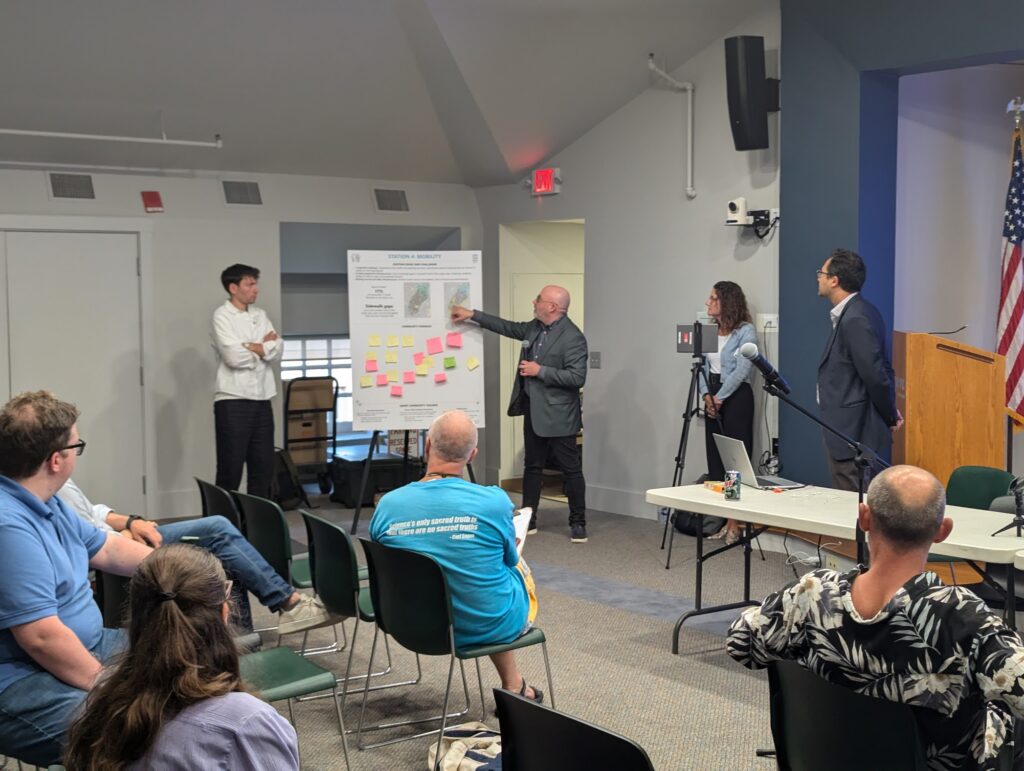 On Tuesday, August 13, 2024, the South Norwalk Library residents gathered for the "South Norwalk Digital Equity and Smart City Public Workshop." This hybrid event held both in-person and online, brought together diverse voices to shape the future of technology in our community.
On Tuesday, August 13, 2024, the South Norwalk Library residents gathered for the "South Norwalk Digital Equity and Smart City Public Workshop." This hybrid event held both in-person and online, brought together diverse voices to shape the future of technology in our community.
Key Highlights
Interactive Discussions
The workshop kicked off with an engaging presentation on digital equity and smart city initiatives. Attendees then broke into small groups, fostering lively discussions about the technological needs of South Norwalk.
Community-Driven Priorities
Participants identified key areas for technological investment, focusing on:
- Improving economic opportunities
- Enhancing public safety
- Bridging the digital divide
These priorities will guide the City of Norwalk and the Norwalk Redevelopment Agency in making informed decisions about future tech investments4.
Innovative Ideas Emerge
Smart Infrastructure
Residents proposed implementing smart streetlights and traffic management systems to improve safety and reduce congestion.
Digital Literacy Programs
The community emphasized the need for accessible training programs to ensure all residents can benefit from new technologies.
Public Wi-Fi Expansion
Participants advocated for broader public Wi-Fi coverage, particularly in underserved areas of South Norwalk.
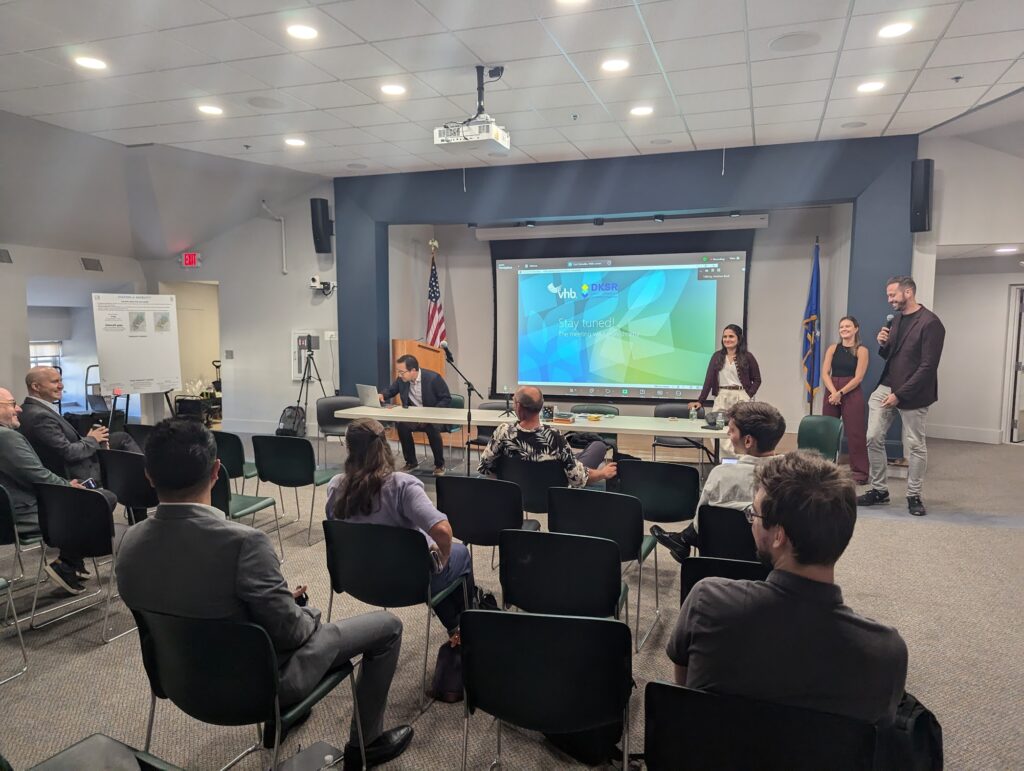
Your Voice Matters
This workshop was just the beginning of an ongoing conversation about South Norwalk's digital future. The Norwalk Redevelopment Agency is committed to incorporating community feedback into its plans.
Stay Involved
- Visit tomorrow.norwalkct.org for updates on future workshops and initiatives.
- Share your ideas on our website's community forum.
- Sign up for the newsletter to stay informed about upcoming events.
Looking Ahead
The insights gathered from this workshop will play a crucial role in shaping South Norwalk's approach to digital equity and smart city technologies. By actively participating in these discussions, you're helping to build a more connected and technologically advanced community for all.
Don't miss out on future opportunities to shape our city's future. Visit tomorrow.norwalkct.org today and become an active part of Norwalk's tomorrow!
 “As the new Director of Sustainability and Resilience, I’m truly impressed by the incredible work in this area that has already been accomplished. From the development of Norwalk’s comprehensive Sustainability and Resilience Plan (SRP), to the implementation of complete streets and the alignment of new zoning with sustainability best practices, it’s clear that Norwalk is leading by example. This progress reflects the dedication and expertise of Mayor Rilling and the City’s leadership and staff, and I’m honored to join such a knowledgeable and committed team. I am very excited about helping tell the full story of Norwalk’s achievements and to advancing new initiatives—like the Flood Resilience Plan—that will make our community even more sustainable, resilient, and future ready.”
“As the new Director of Sustainability and Resilience, I’m truly impressed by the incredible work in this area that has already been accomplished. From the development of Norwalk’s comprehensive Sustainability and Resilience Plan (SRP), to the implementation of complete streets and the alignment of new zoning with sustainability best practices, it’s clear that Norwalk is leading by example. This progress reflects the dedication and expertise of Mayor Rilling and the City’s leadership and staff, and I’m honored to join such a knowledgeable and committed team. I am very excited about helping tell the full story of Norwalk’s achievements and to advancing new initiatives—like the Flood Resilience Plan—that will make our community even more sustainable, resilient, and future ready.”



 Photo credit: Tracy Craighead[/caption]
Photo credit: Tracy Craighead[/caption]
 Photo credit: Tracy Craighead[/caption]
Photo credit: Tracy Craighead[/caption]
 Photo credit: Tracy Craighead[/caption]
Photo credit: Tracy Craighead[/caption]
 Photo credit: Tracy Craighead[/caption]
Photo credit: Tracy Craighead[/caption]

 Recommendations of the AHAP were consolidated into four categories:
Recommendations of the AHAP were consolidated into four categories:
 Th
Th




 Photo Credit: Visit Norwalk[/caption]
Photo Credit: Visit Norwalk[/caption]
 Photo Credit: Norwalk Seaport Association[/caption]
Photo Credit: Norwalk Seaport Association[/caption]



 Photo Credit: Mike Mushak[/caption]
Photo Credit: Mike Mushak[/caption]
 Photo Credit: Connecticut Historical Commission[/caption]
Photo Credit: Connecticut Historical Commission[/caption]
 Photo Credit: The Cecil Group for the Norwalk Redevelopment Agency[/caption]
Photo Credit: The Cecil Group for the Norwalk Redevelopment Agency[/caption]
 Photo Credit: Connecticut Historical Commission[/caption]
Photo Credit: Connecticut Historical Commission[/caption]
 Photo Credit: Norwalk Earth Day 2024[/caption]
Photo Credit: Norwalk Earth Day 2024[/caption]
 Photo Credit: Tod Bryant[/caption]
Photo Credit: Tod Bryant[/caption]
 Photo Credit: The Norwalk Hour[/caption]
Photo Credit: The Norwalk Hour[/caption]
 Photo Credit: The Monster Studio[/caption]
Photo Credit: The Monster Studio[/caption]
 Photo Credit: Norwalk Arts & Culture Commission[/caption]
Photo Credit: Norwalk Arts & Culture Commission[/caption] Photo Credit: Geoffrey Steadman[/caption]
Nestled along Norwalk's coastline, Manresa Island stands as a testament to Connecticut's industrial past and a beacon of its sustainable future. This 144-acre property, once home to a power plant, is now poised for an exciting transformation that promises to reshape the landscape and enrich the community.
The long-awaited transformation of Manresa Island is finally taking shape. This ambitious project promises to turn a former industrial site into a stunning public park and community hub that will redefine our city's waterfront.
Local philanthropists Austin and Allison McChord have purchased the 125-acre brownfield site for $40 million, with plans to develop it as a gift to their hometown. This generous initiative ensures that Manresa Island will become a cherished public space for generations to come.
Photo Credit: Geoffrey Steadman[/caption]
Nestled along Norwalk's coastline, Manresa Island stands as a testament to Connecticut's industrial past and a beacon of its sustainable future. This 144-acre property, once home to a power plant, is now poised for an exciting transformation that promises to reshape the landscape and enrich the community.
The long-awaited transformation of Manresa Island is finally taking shape. This ambitious project promises to turn a former industrial site into a stunning public park and community hub that will redefine our city's waterfront.
Local philanthropists Austin and Allison McChord have purchased the 125-acre brownfield site for $40 million, with plans to develop it as a gift to their hometown. This generous initiative ensures that Manresa Island will become a cherished public space for generations to come.
 Photo Credit: Geoffrey Steadman[/caption]
Photo Credit: Geoffrey Steadman[/caption]
 Photo Credit: Geoffrey Steadman[/caption]
Photo Credit: Geoffrey Steadman[/caption]
 Families come in a variety of shapes and sizes. More younger family members are living at home for longer. Older family members are also beginning to move in with younger members to be taken care of or to help with childcare. Regardless of what your family looks like, it’s important to have enough space for everyone in your household.
Families come in a variety of shapes and sizes. More younger family members are living at home for longer. Older family members are also beginning to move in with younger members to be taken care of or to help with childcare. Regardless of what your family looks like, it’s important to have enough space for everyone in your household.
 If you have a single-family home, it can be hard to house extra family members or children who need to live at home longer but want their own space. One of the biggest benefits of owning an ADU is that you create space for family members who need it.
Depending on the location of the dwelling, you can also rent it out to make extra income. ADUs can increase the value of your property by 20%-30%. It can also appeal to more buyers when you go to sell your home.
These dwellings can also help reduce gentrification and desegregate neighborhoods by giving opportunities to people who otherwise might not be able to afford to live in certain neighborhoods.
If you have a single-family home, it can be hard to house extra family members or children who need to live at home longer but want their own space. One of the biggest benefits of owning an ADU is that you create space for family members who need it.
Depending on the location of the dwelling, you can also rent it out to make extra income. ADUs can increase the value of your property by 20%-30%. It can also appeal to more buyers when you go to sell your home.
These dwellings can also help reduce gentrification and desegregate neighborhoods by giving opportunities to people who otherwise might not be able to afford to live in certain neighborhoods.




